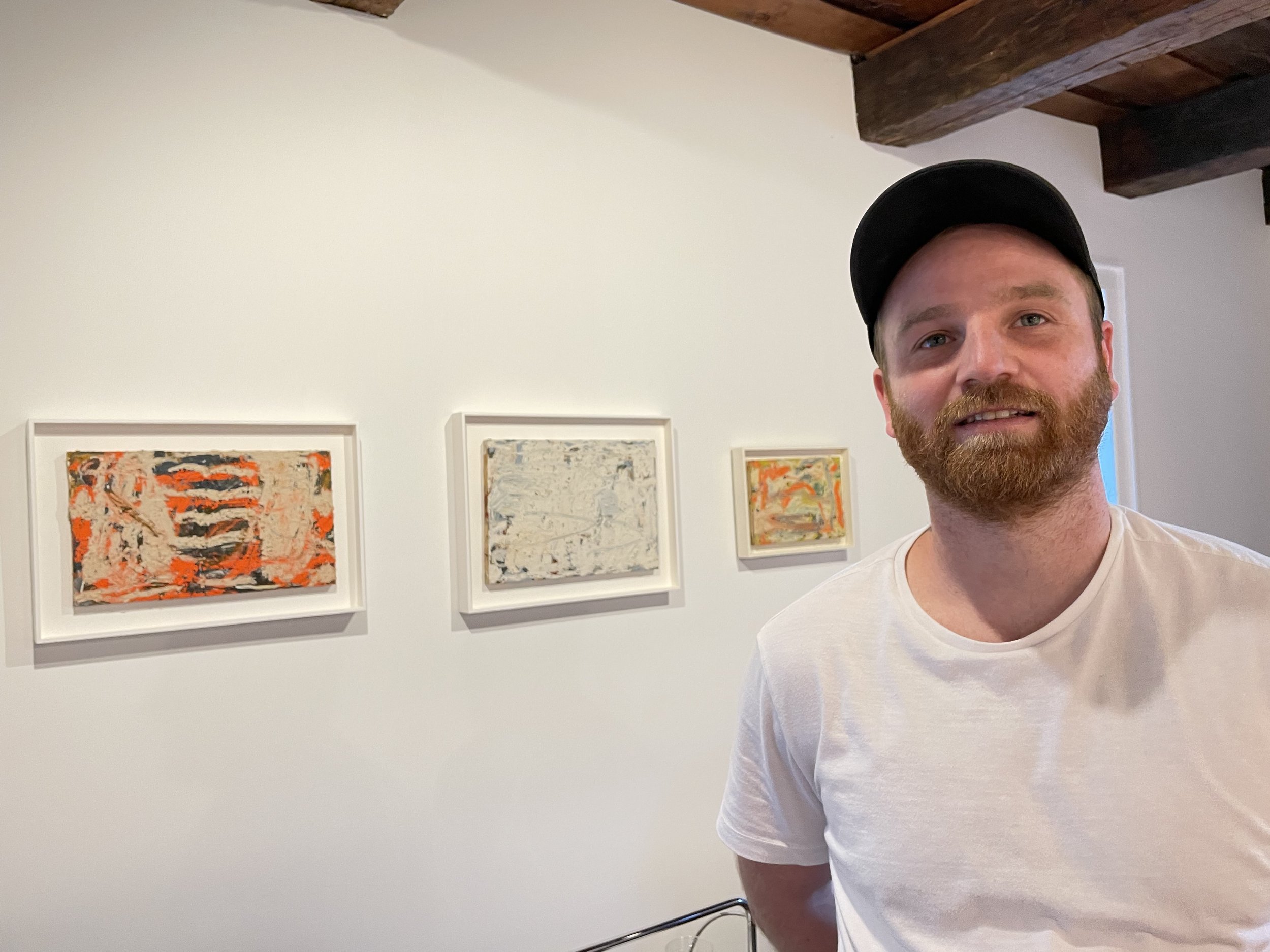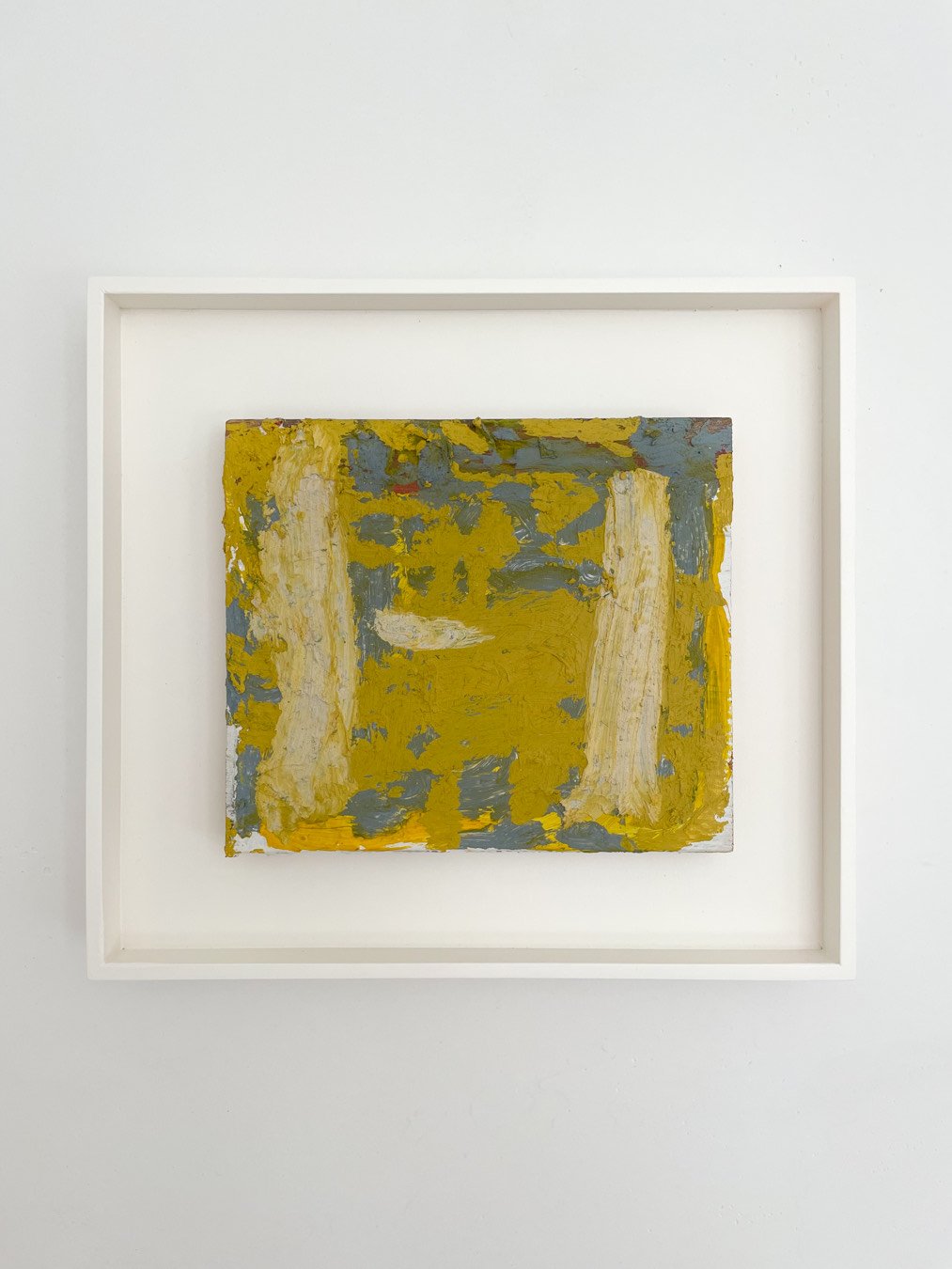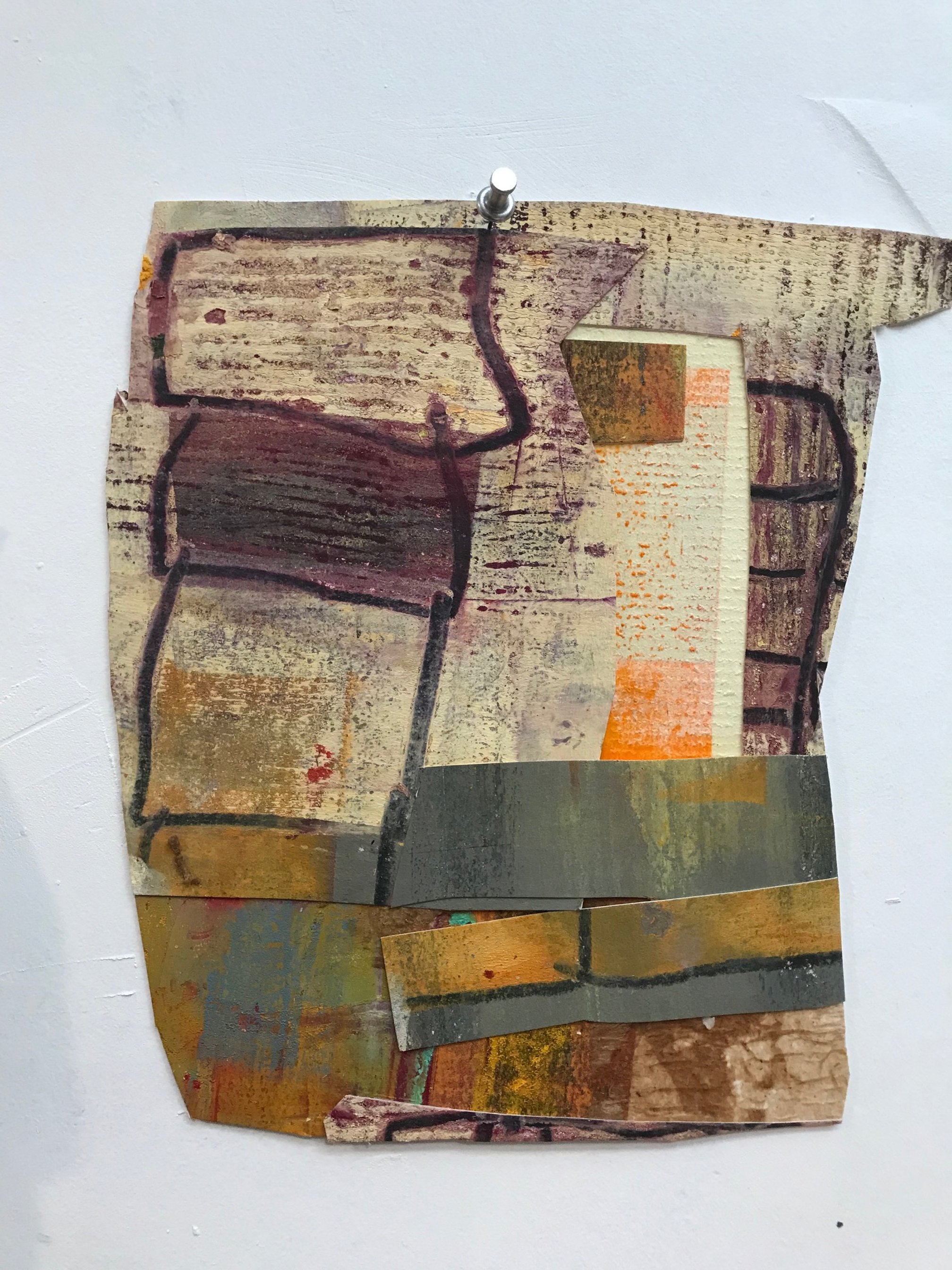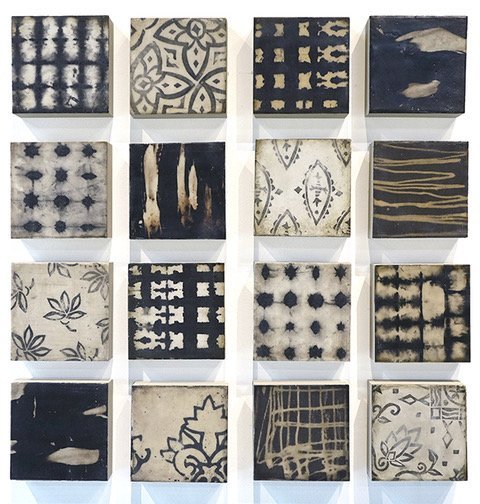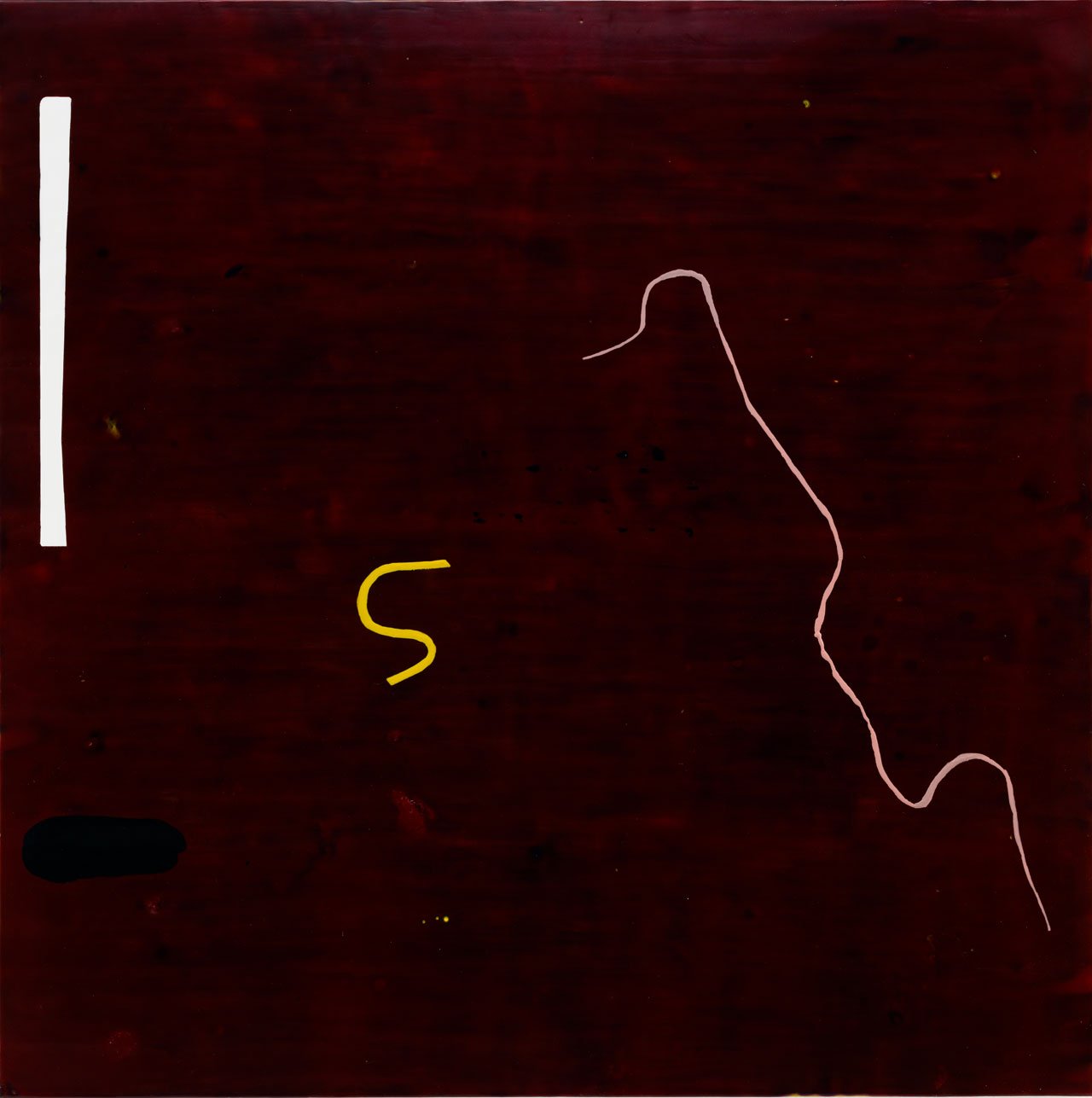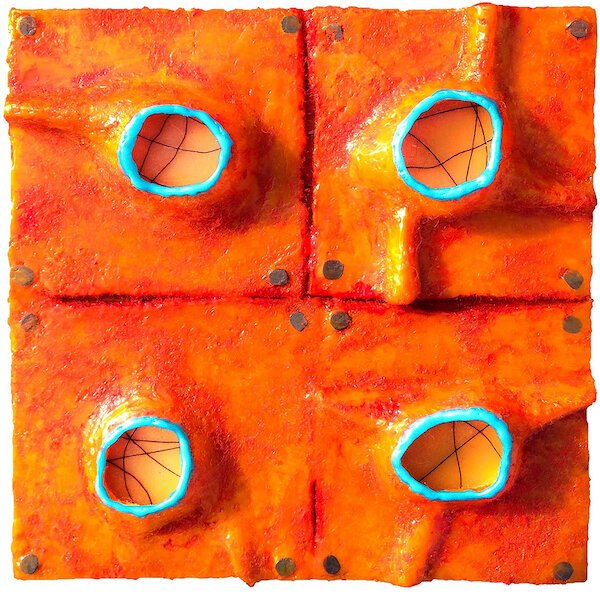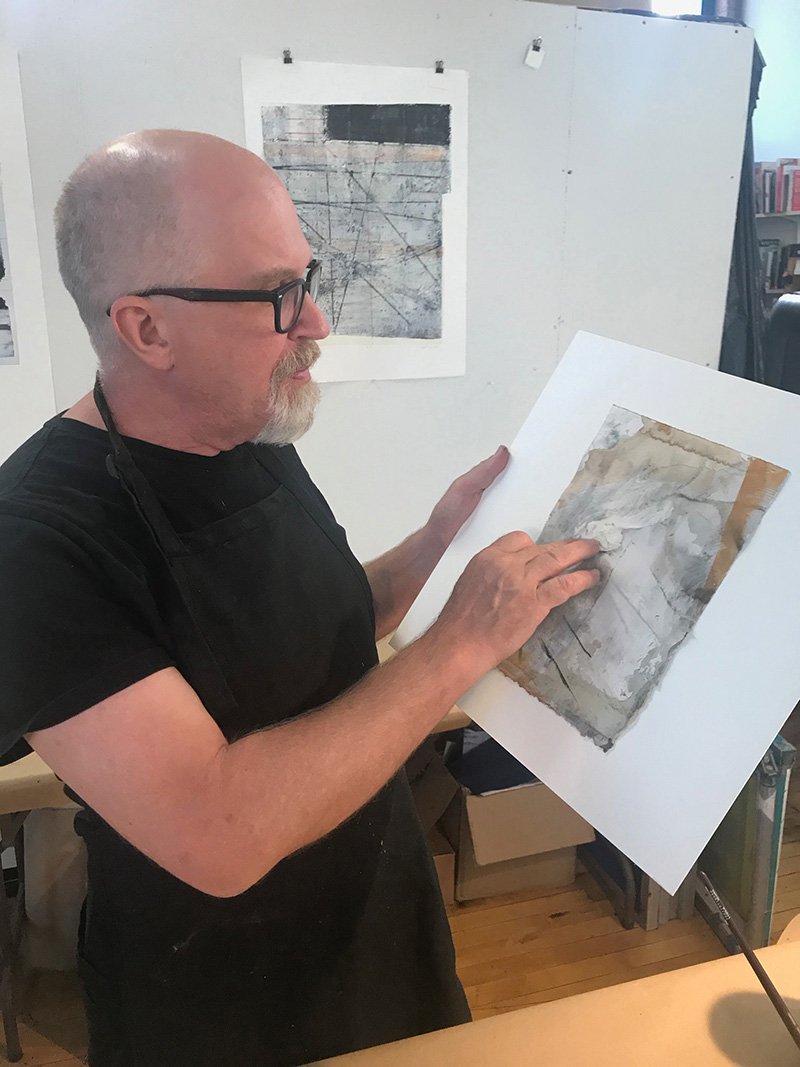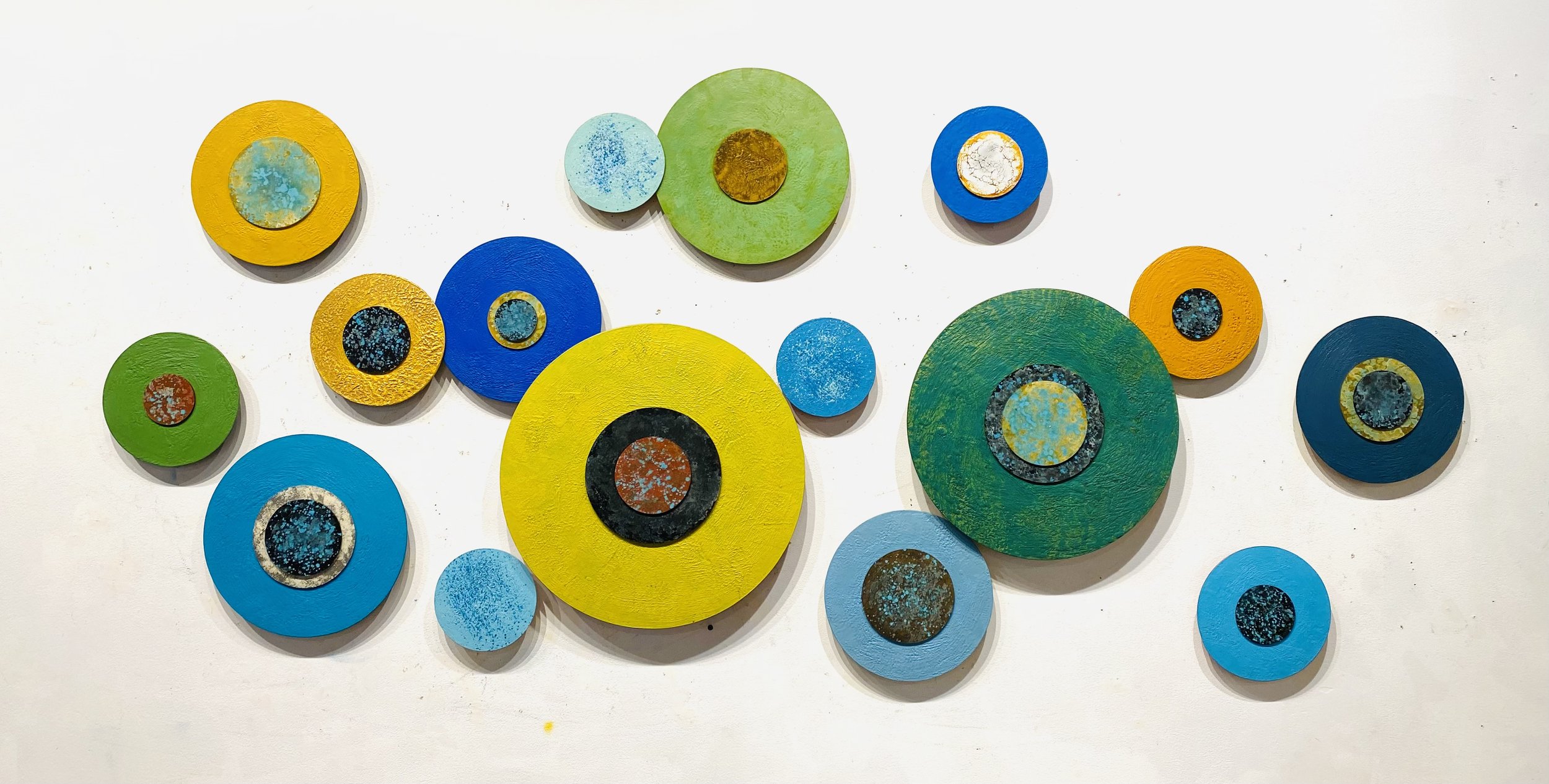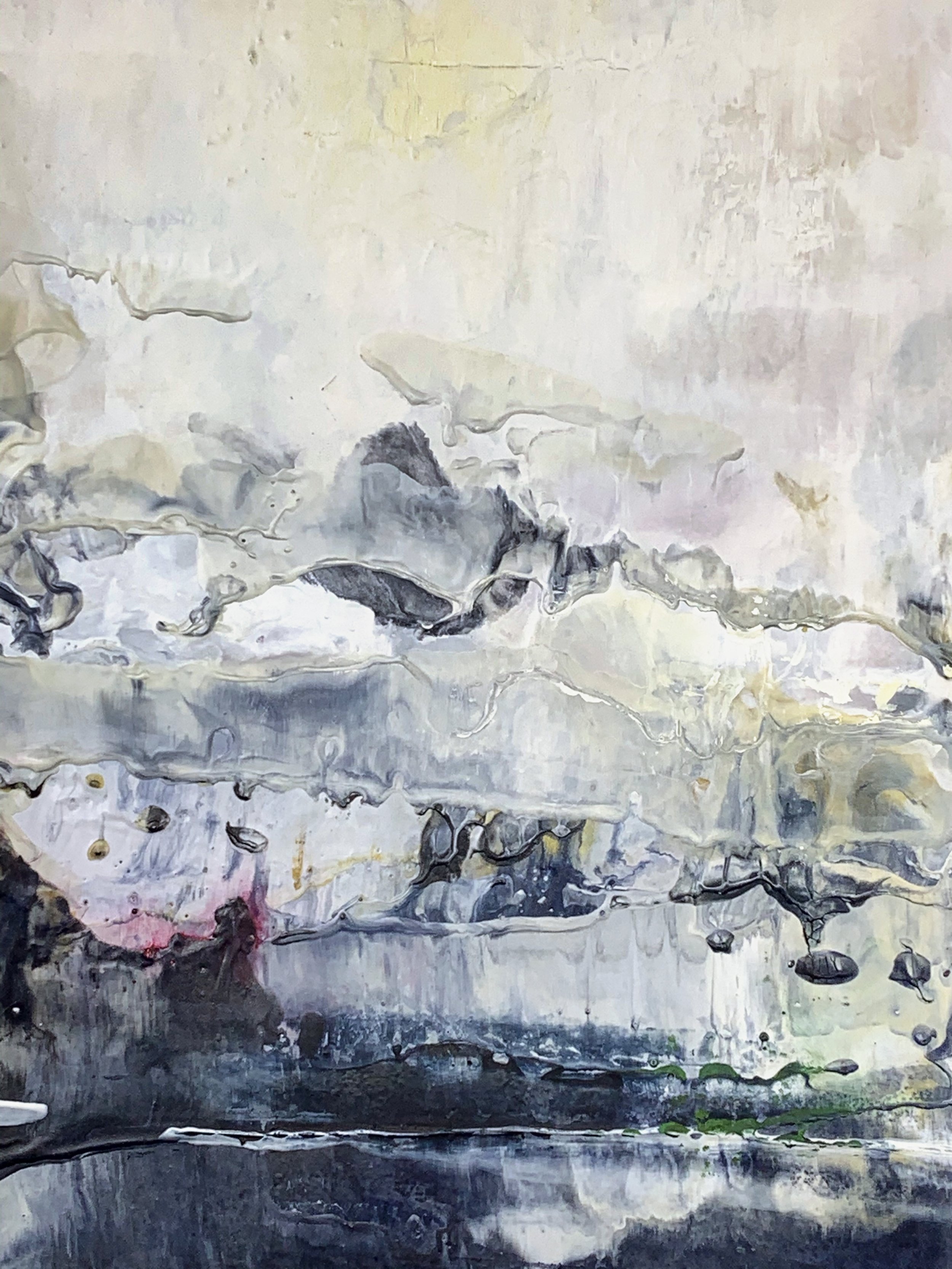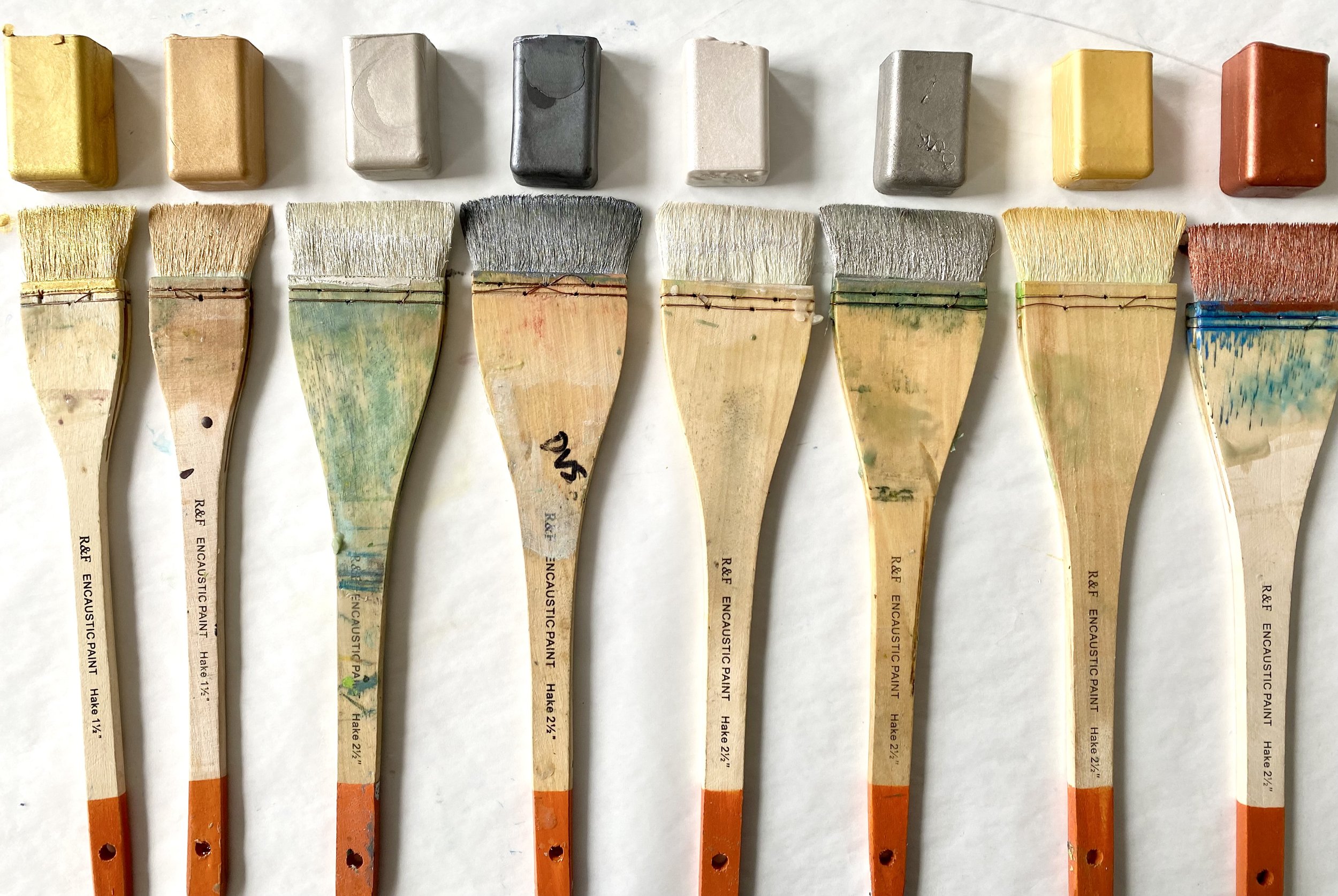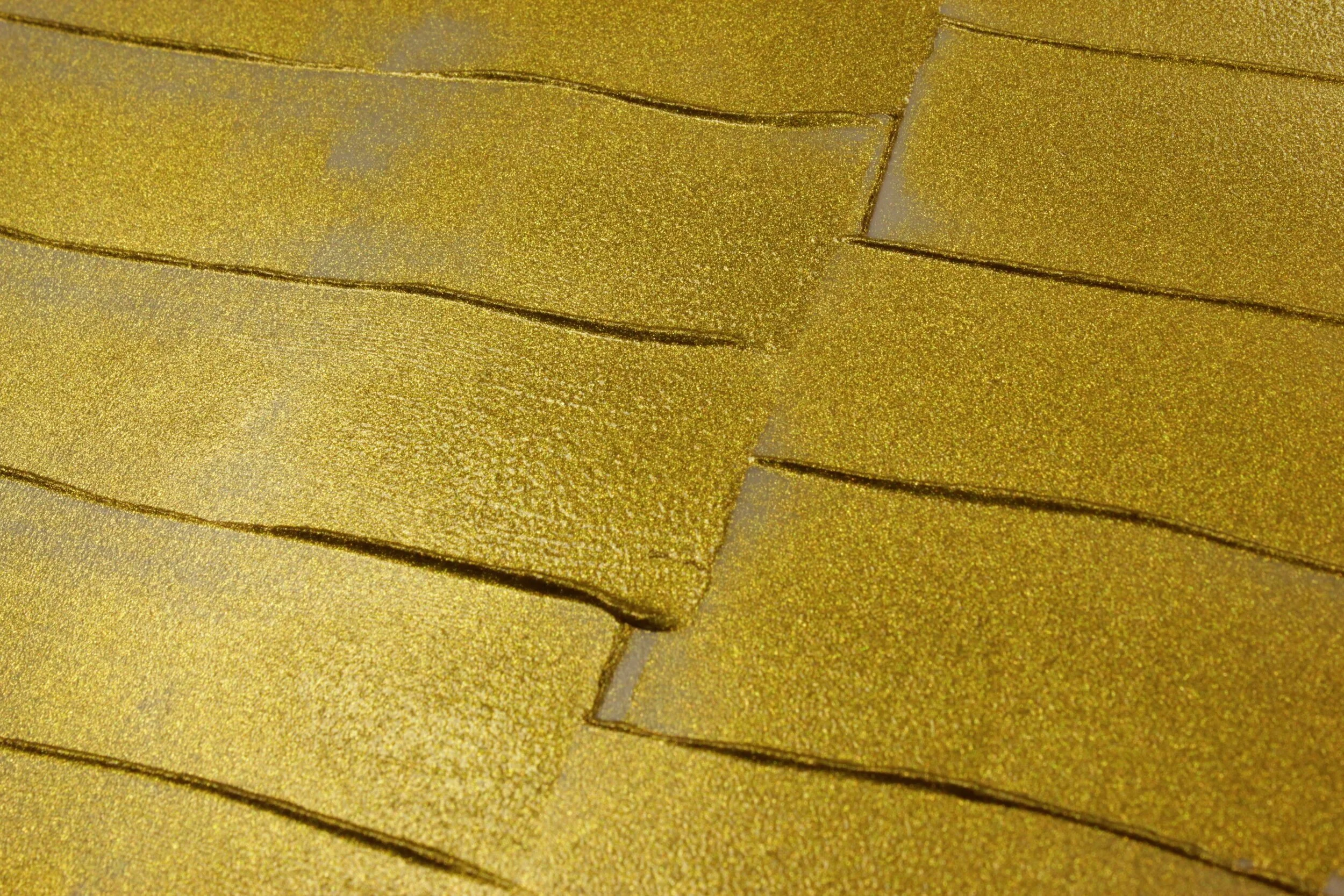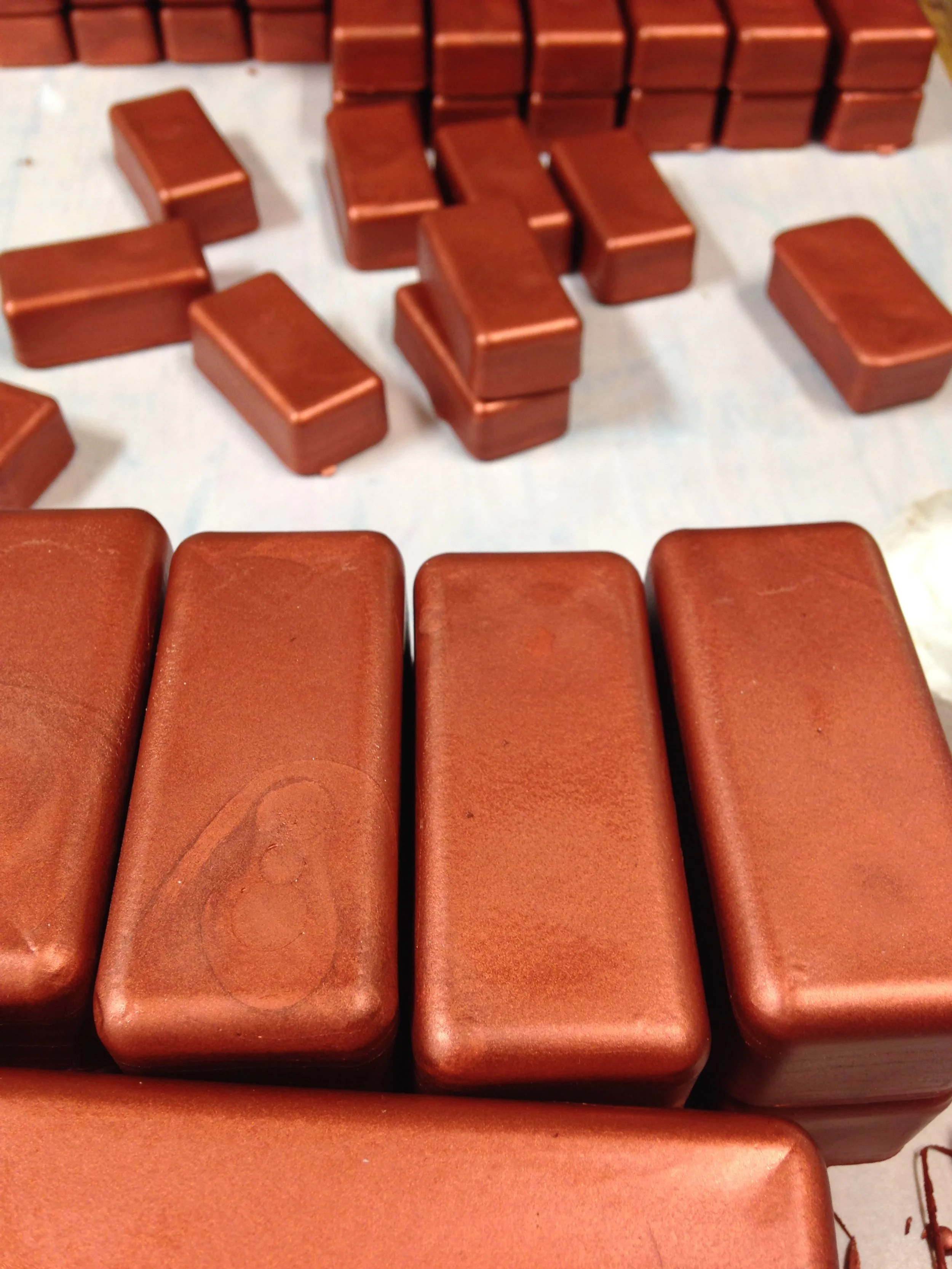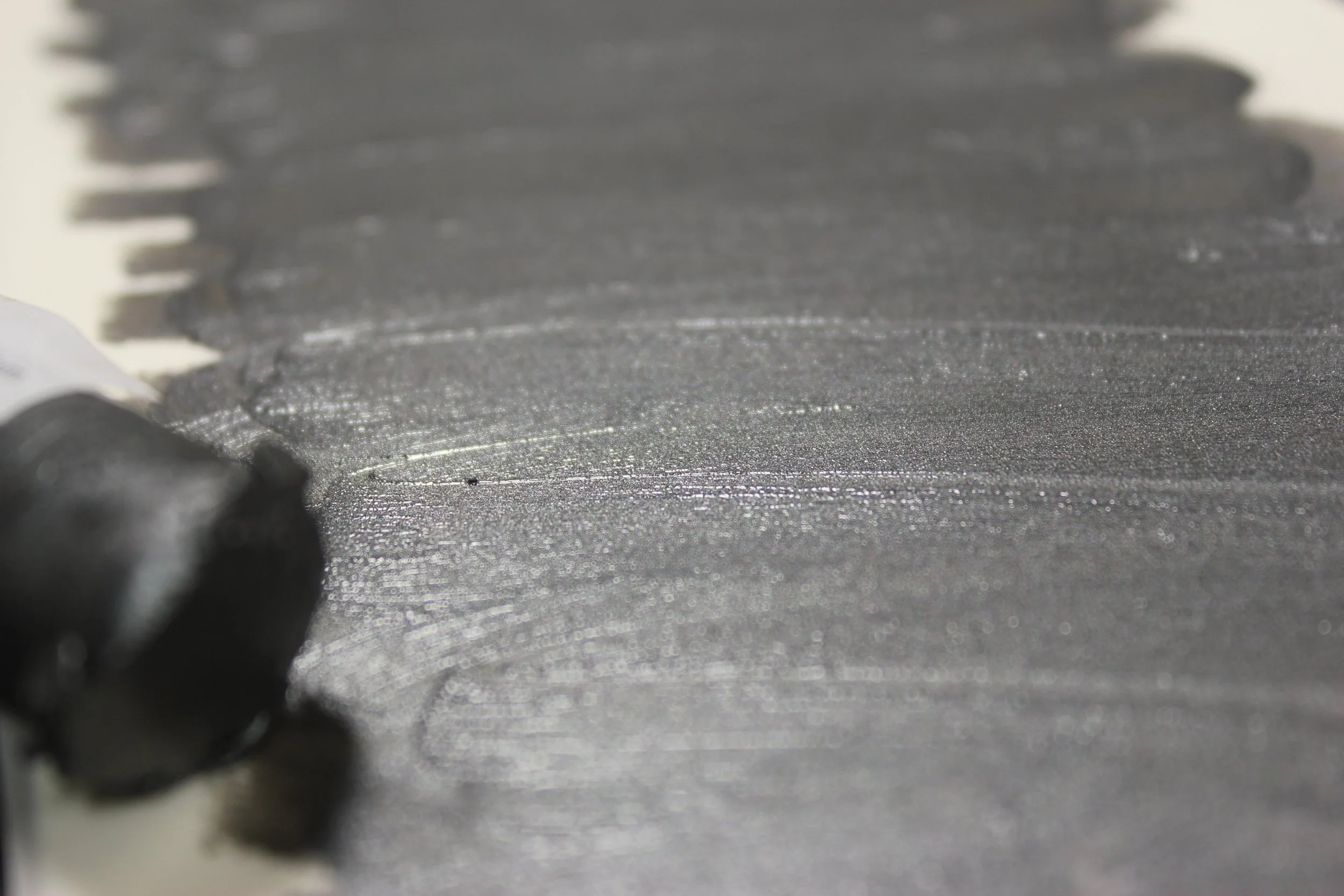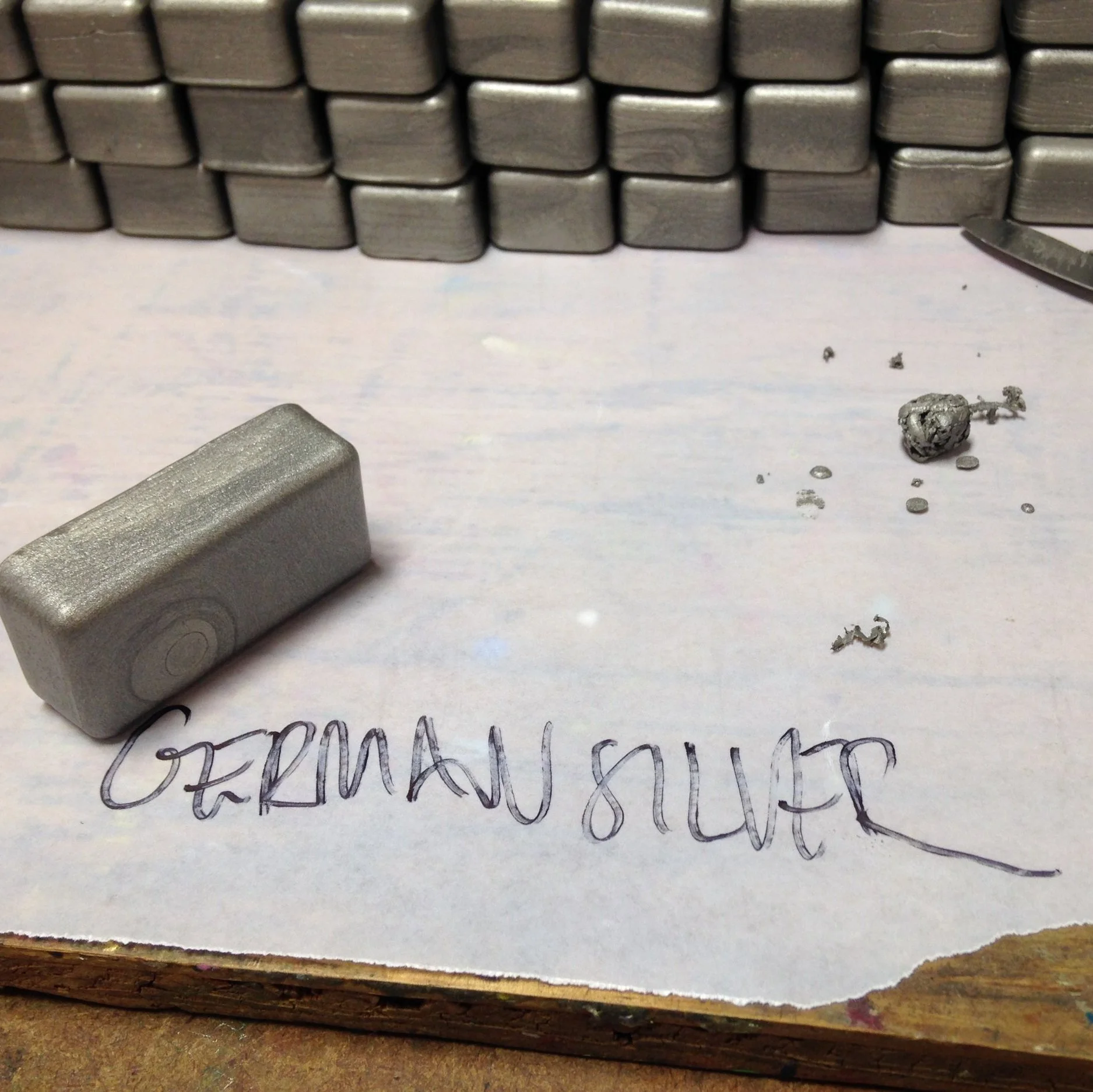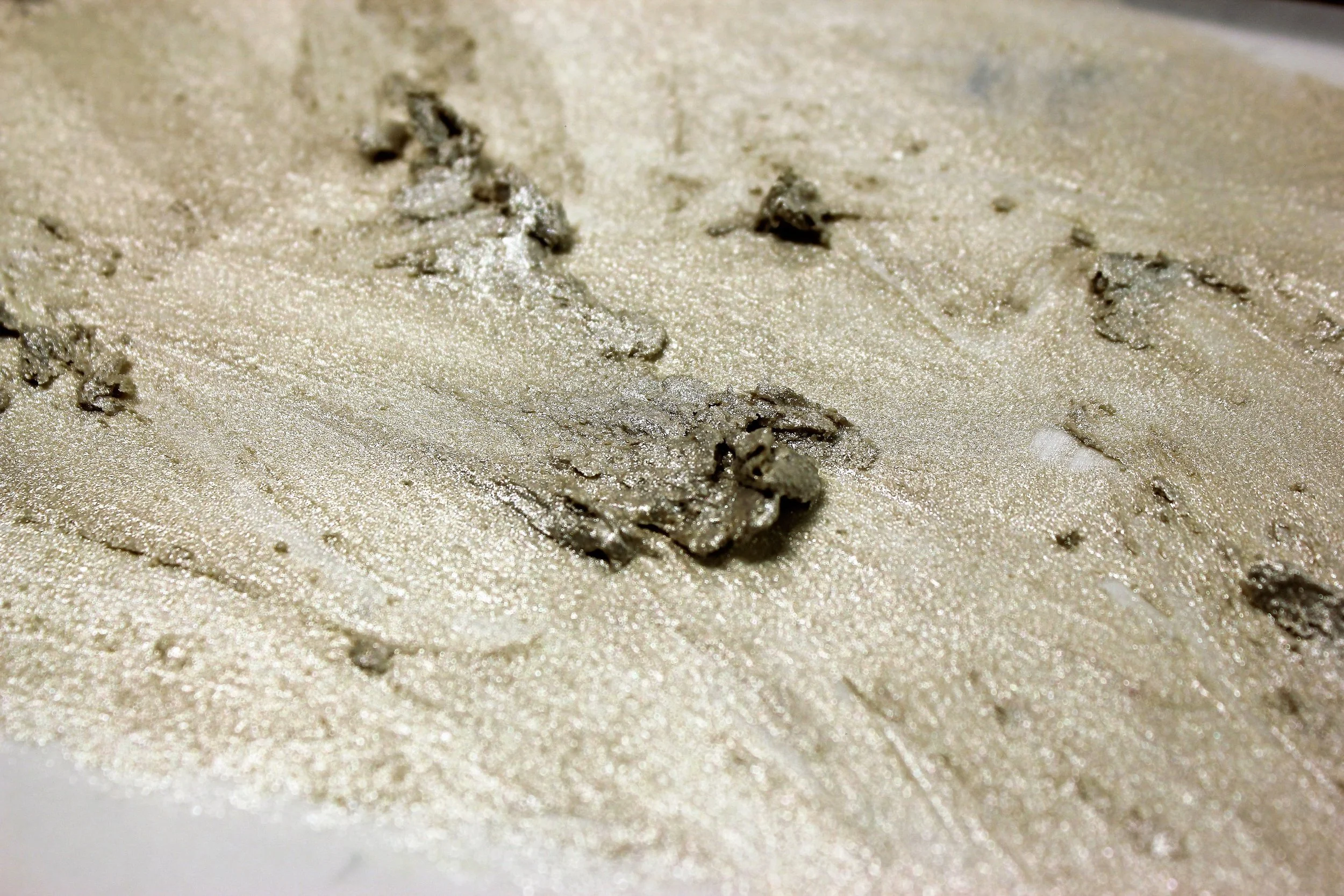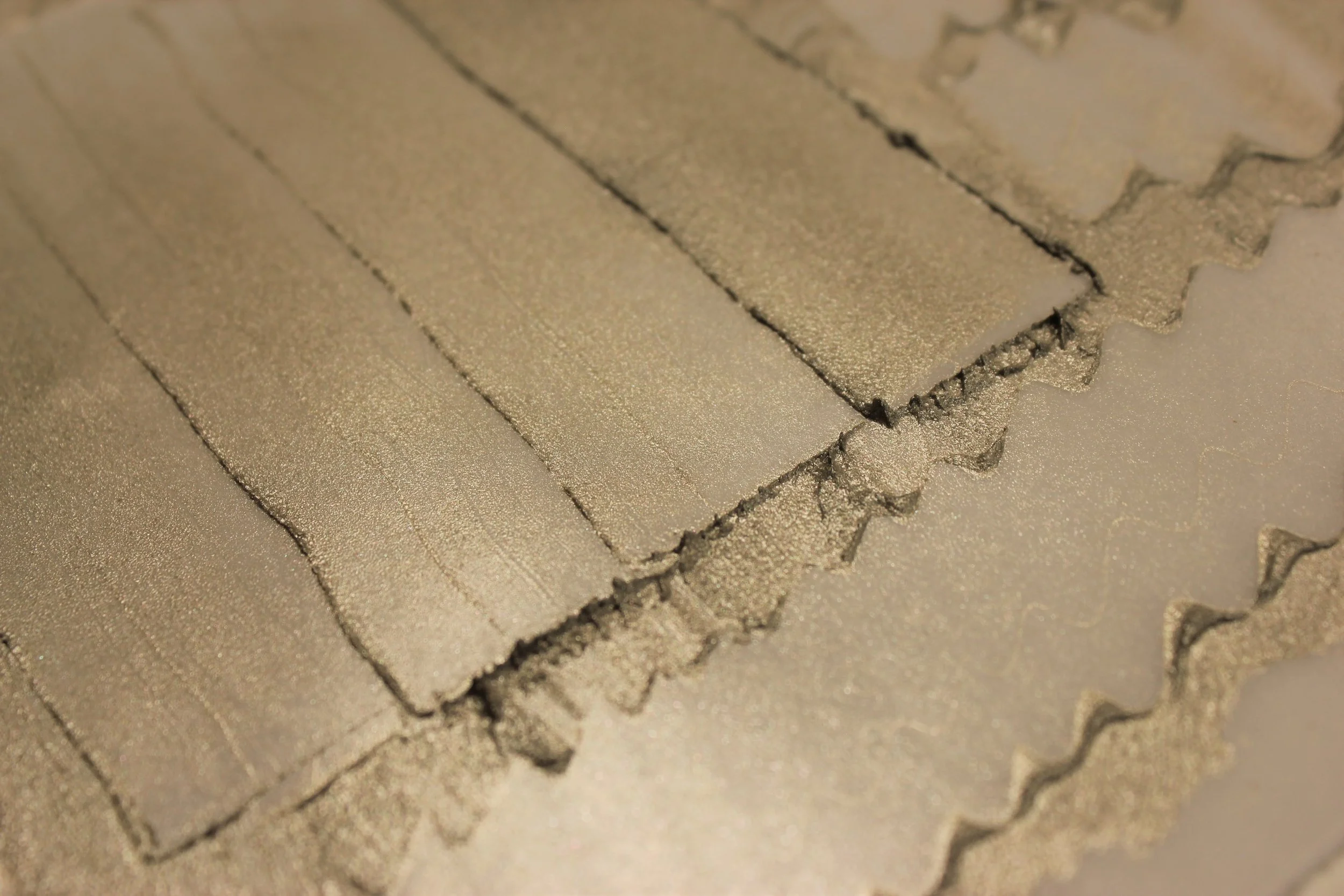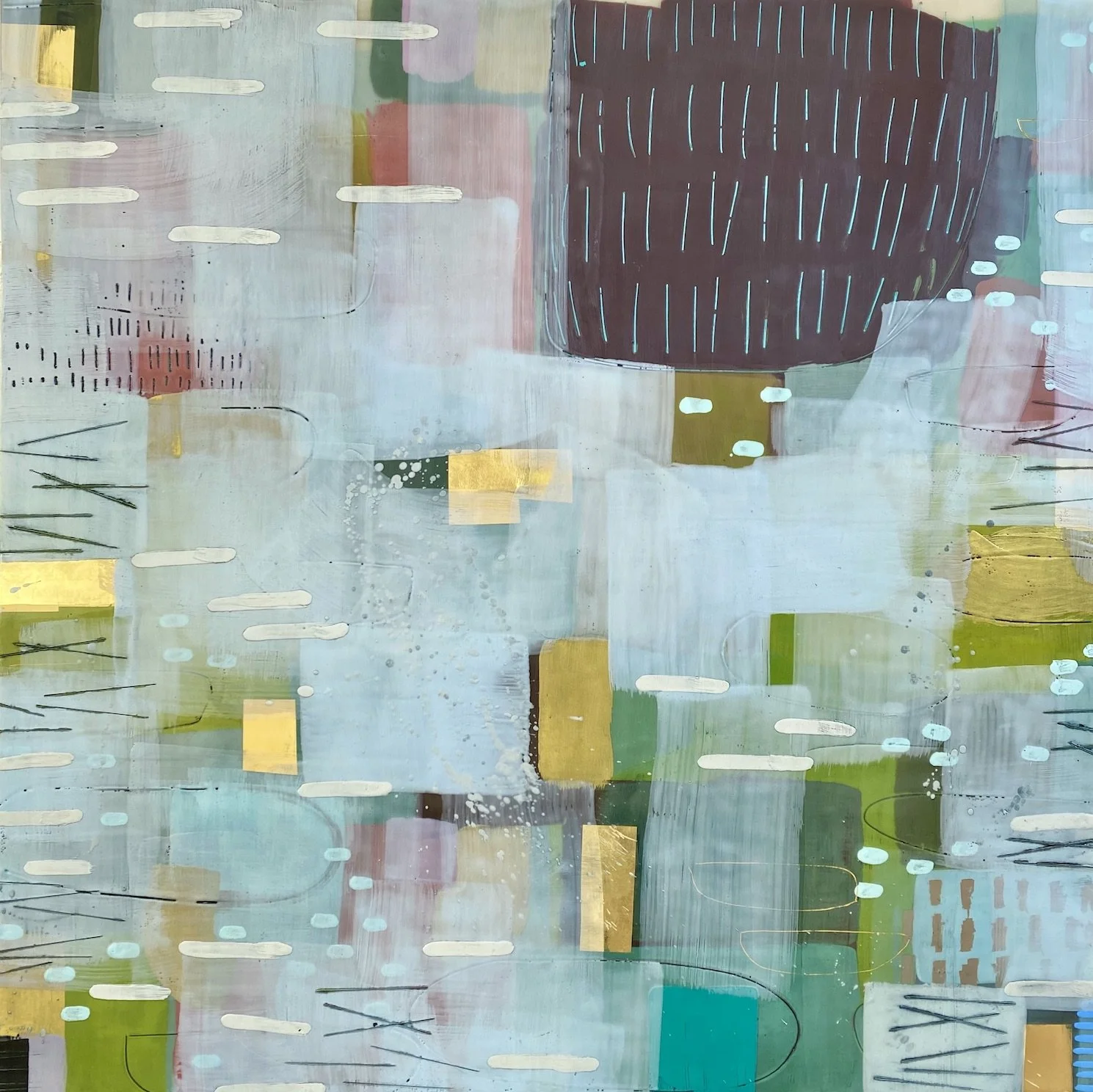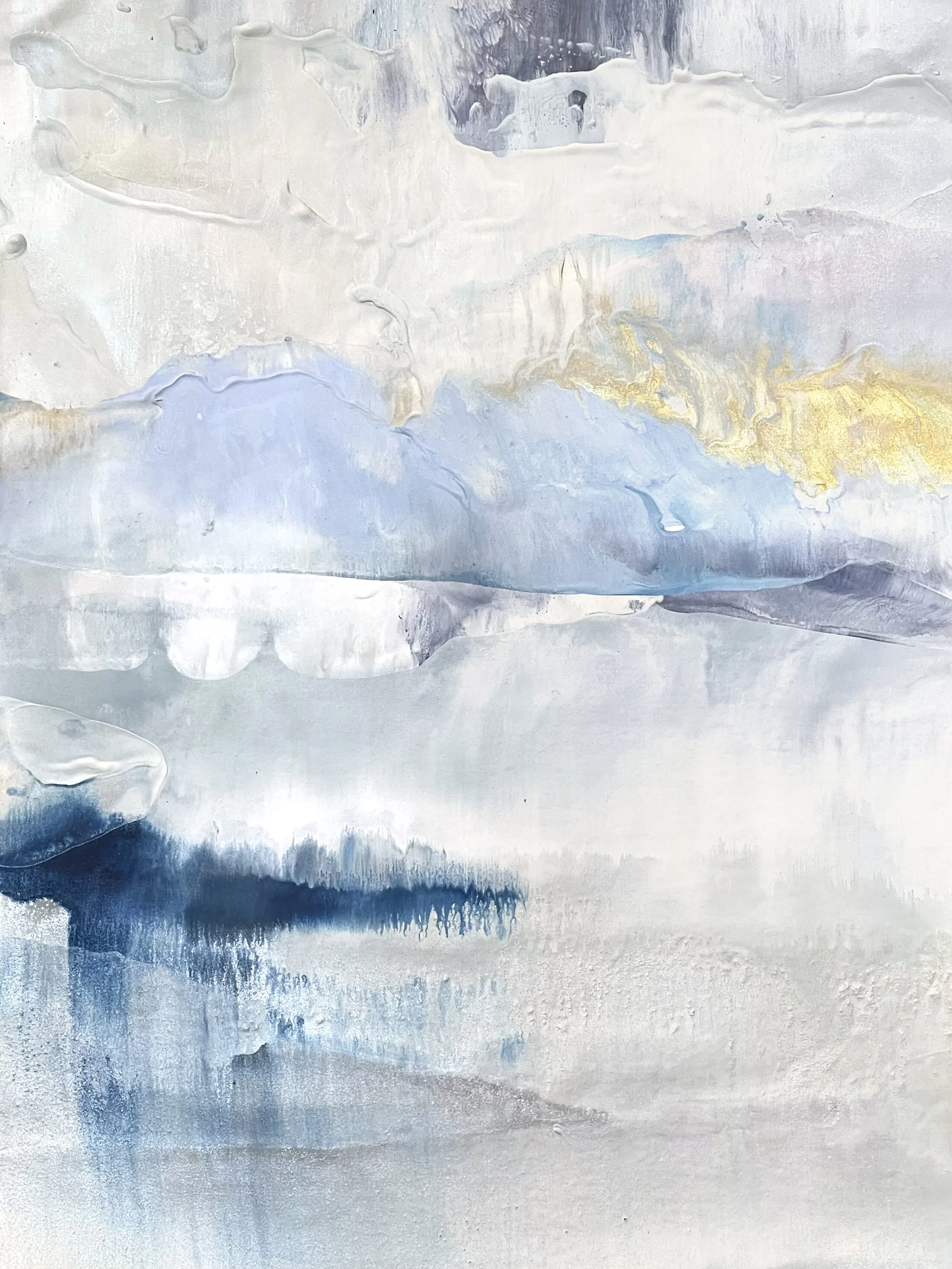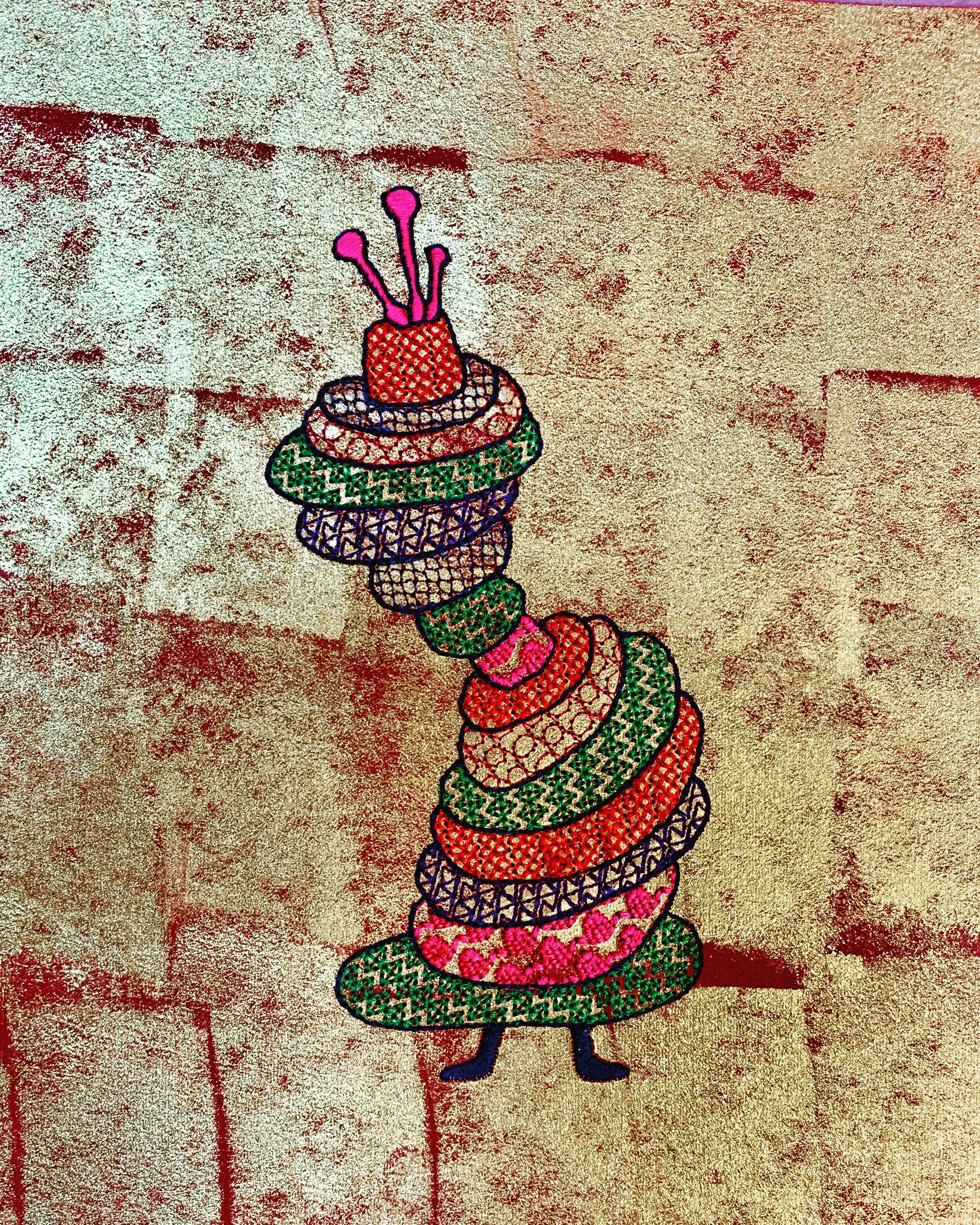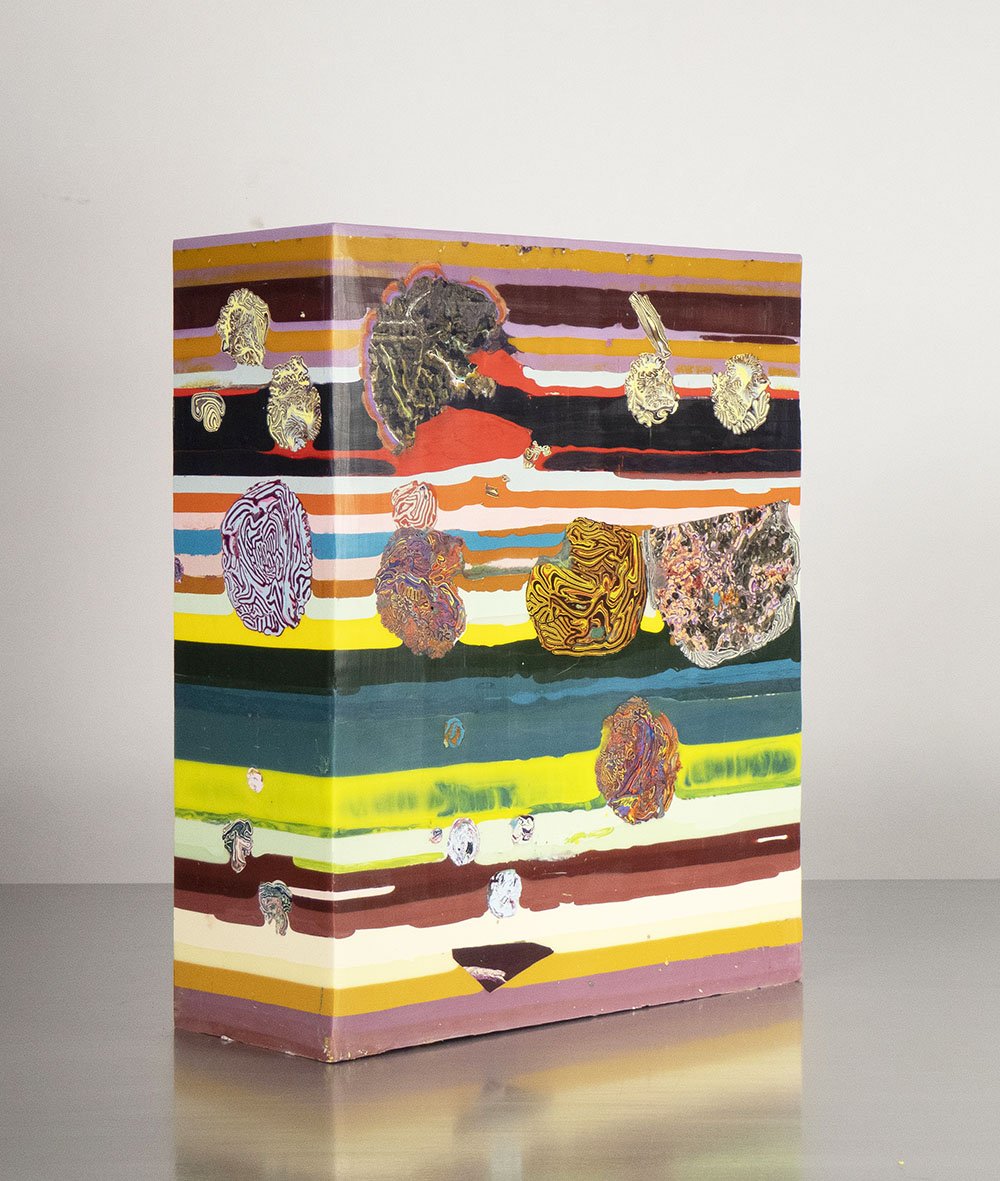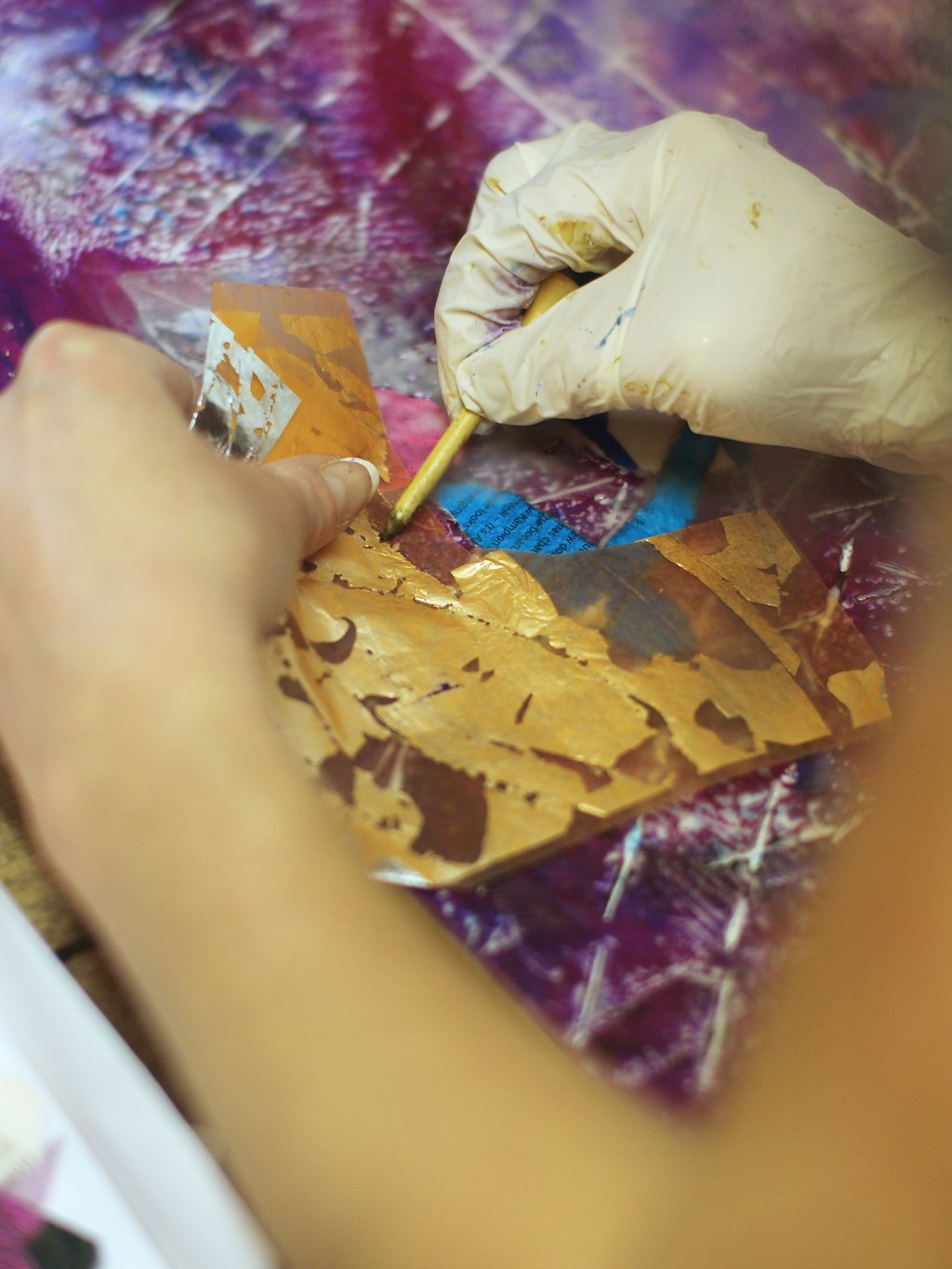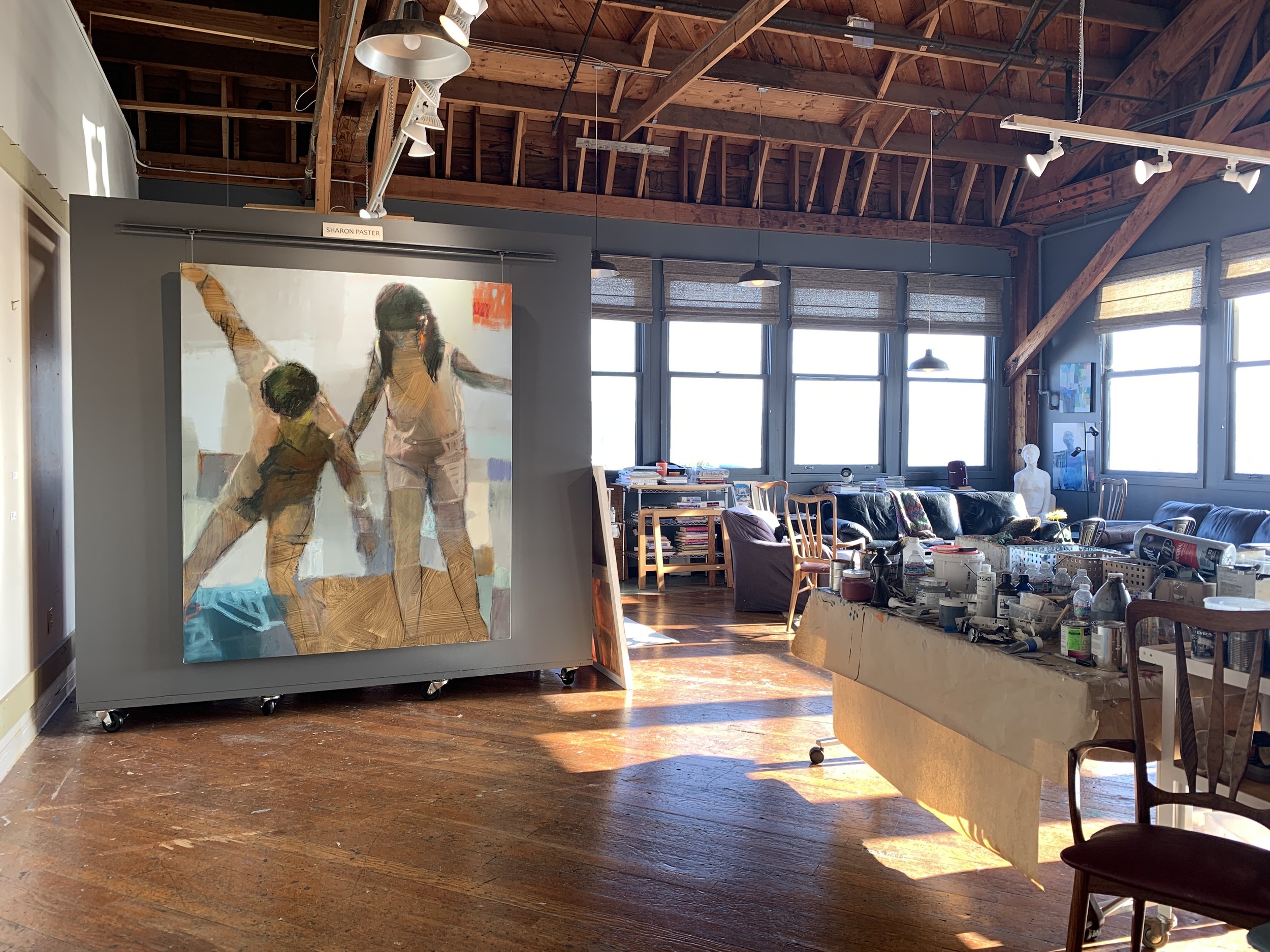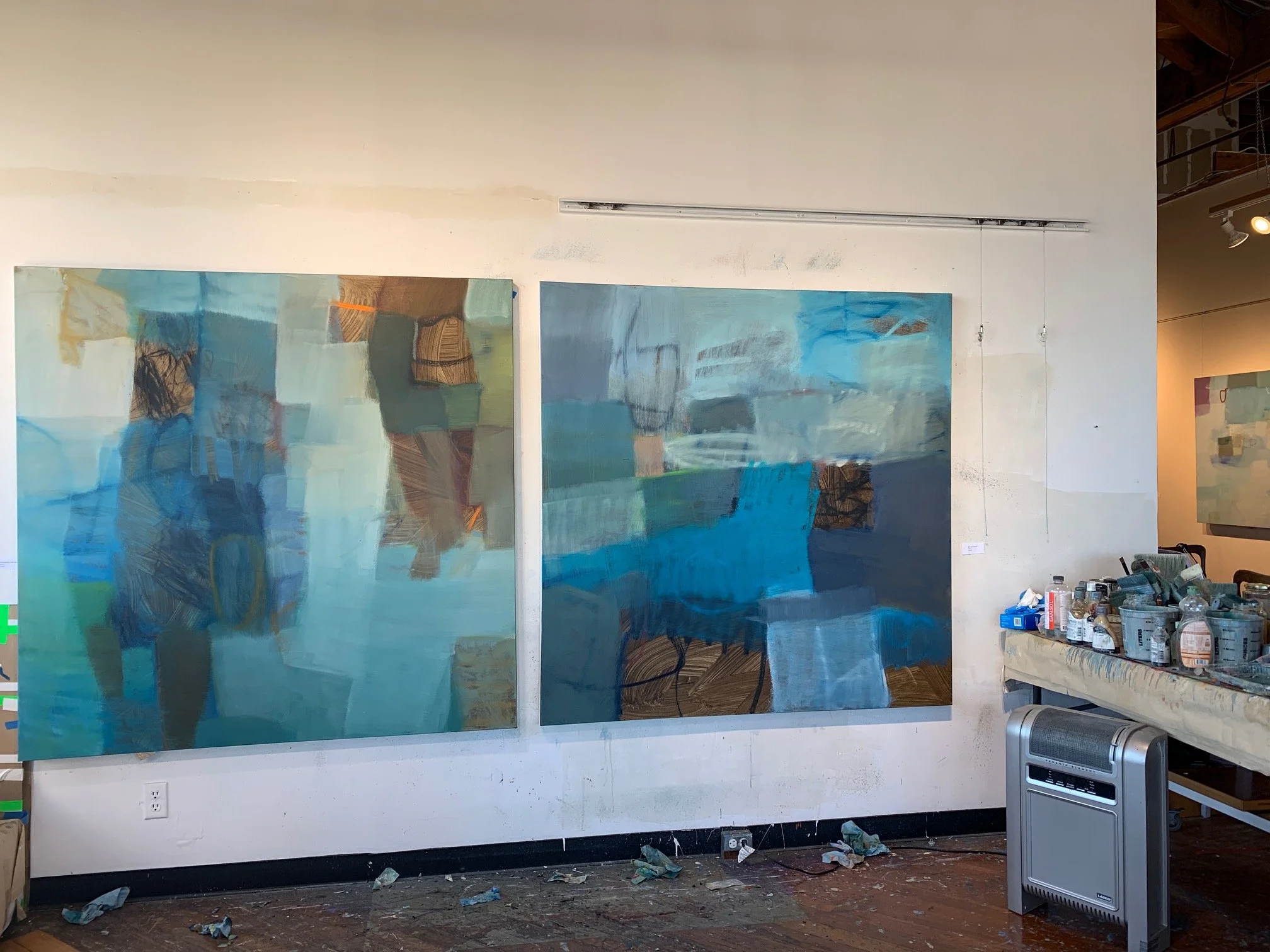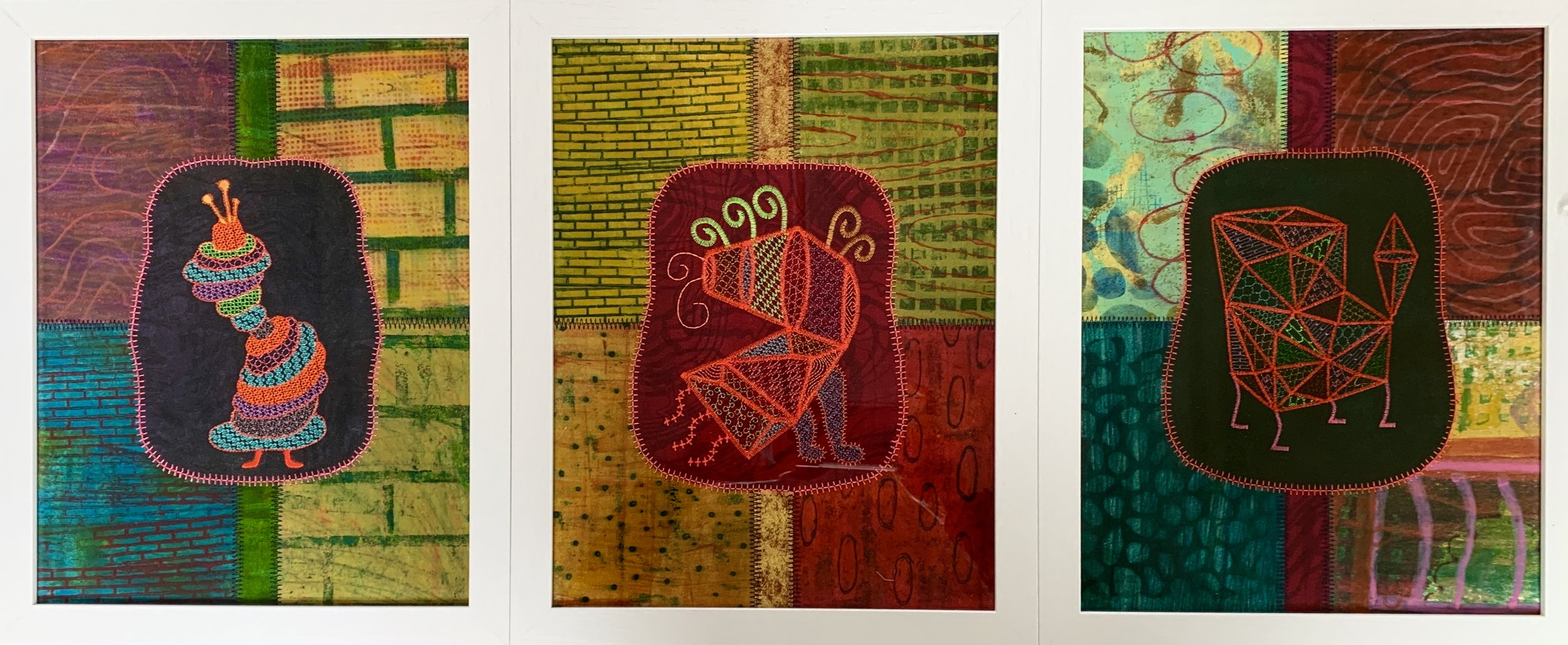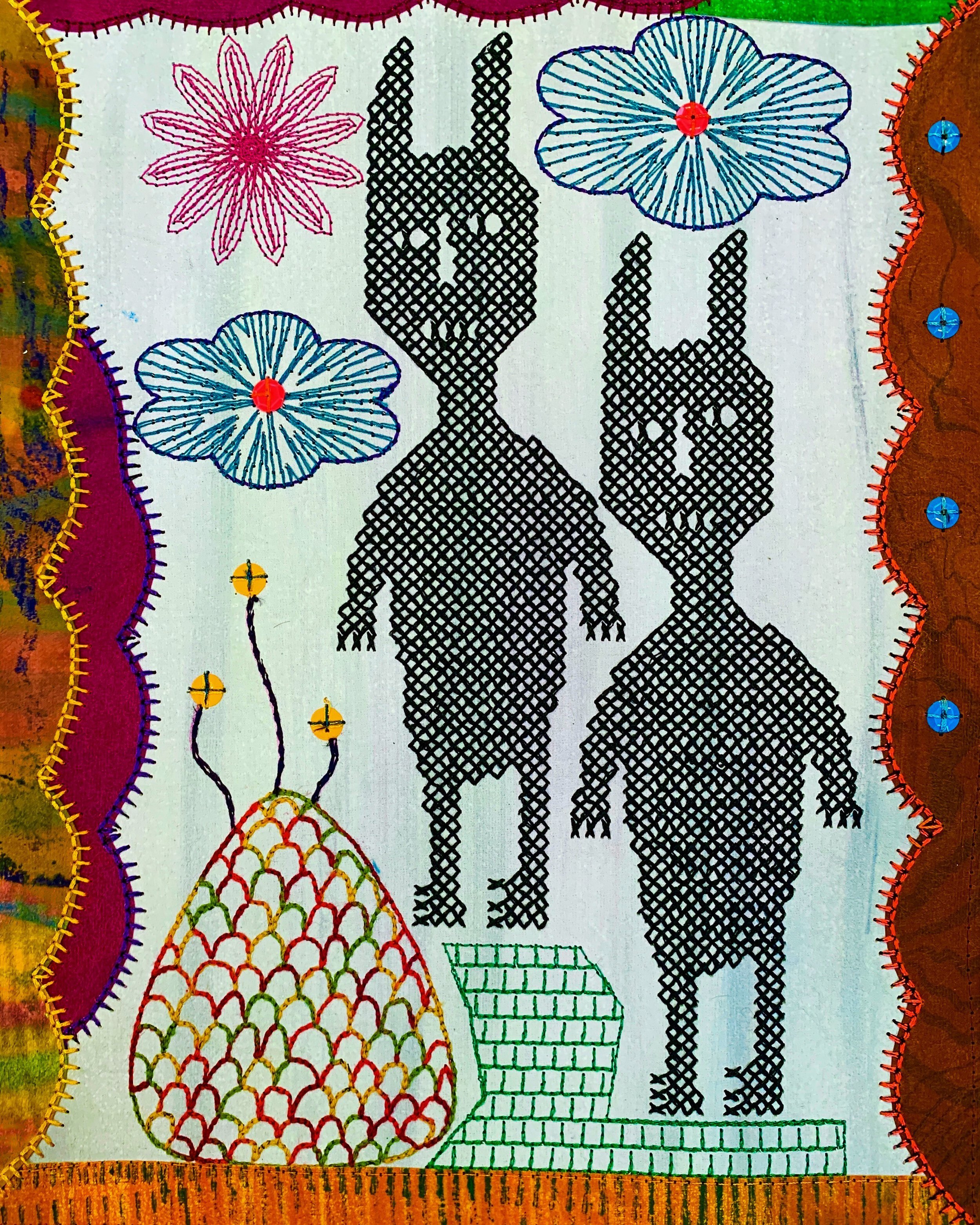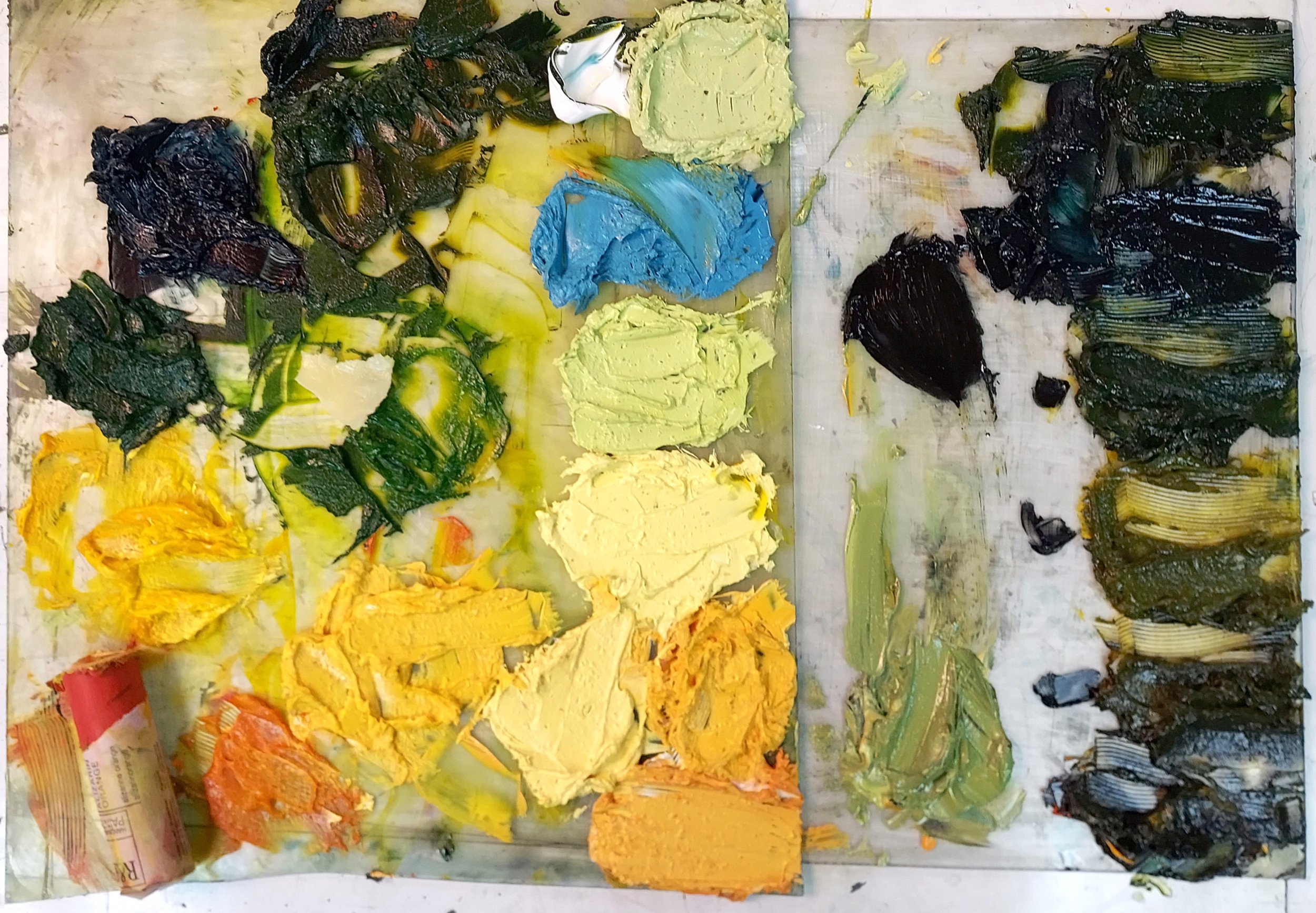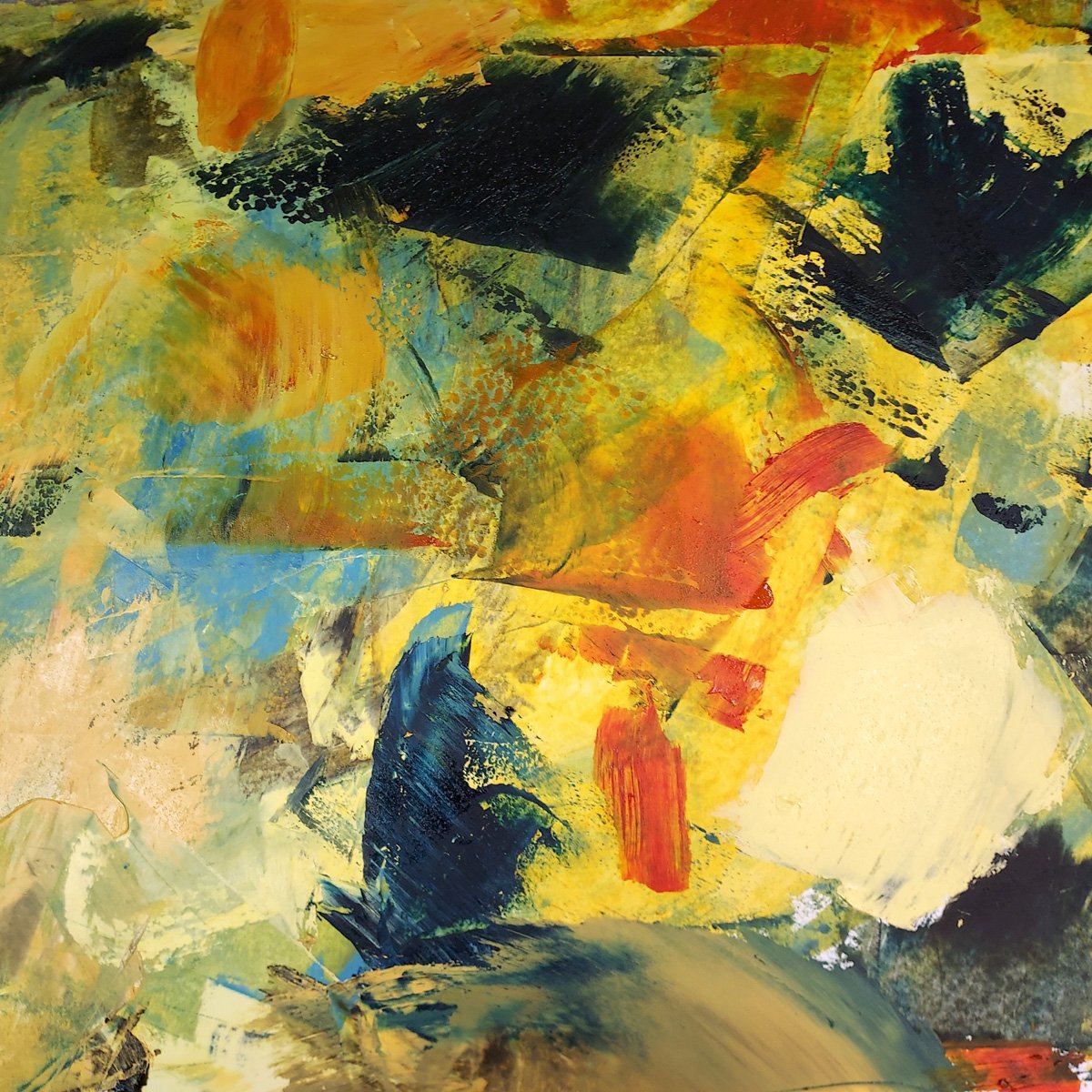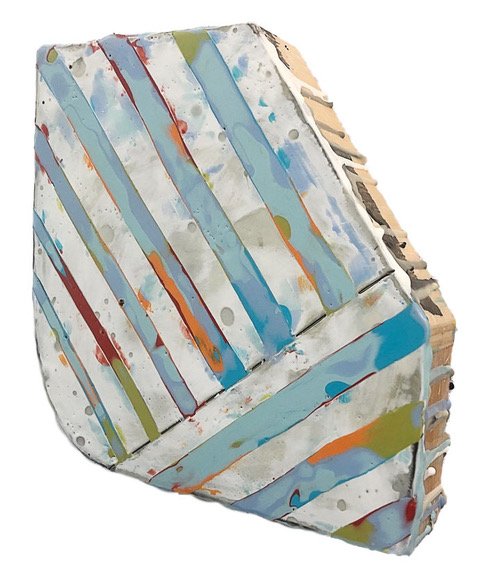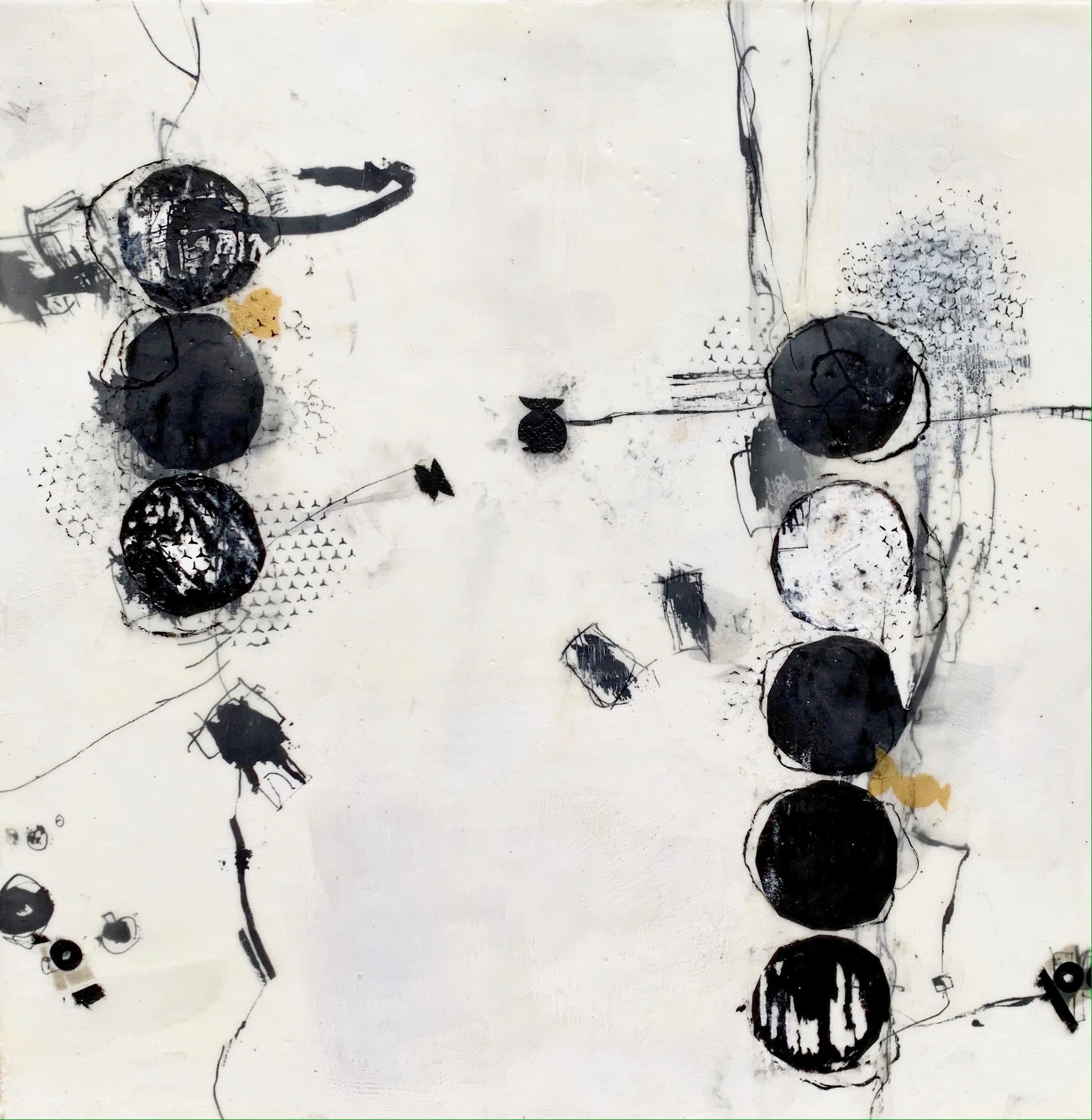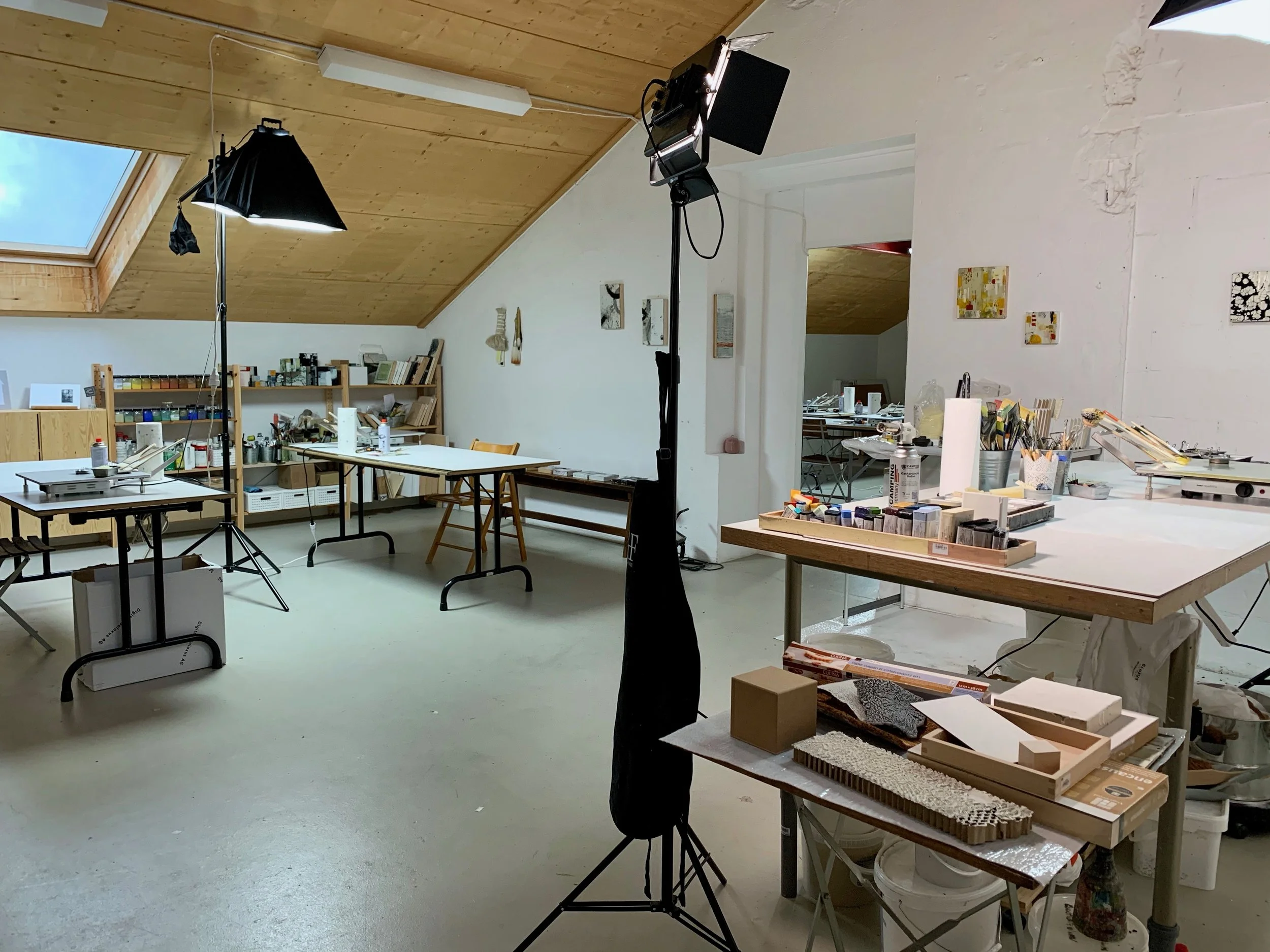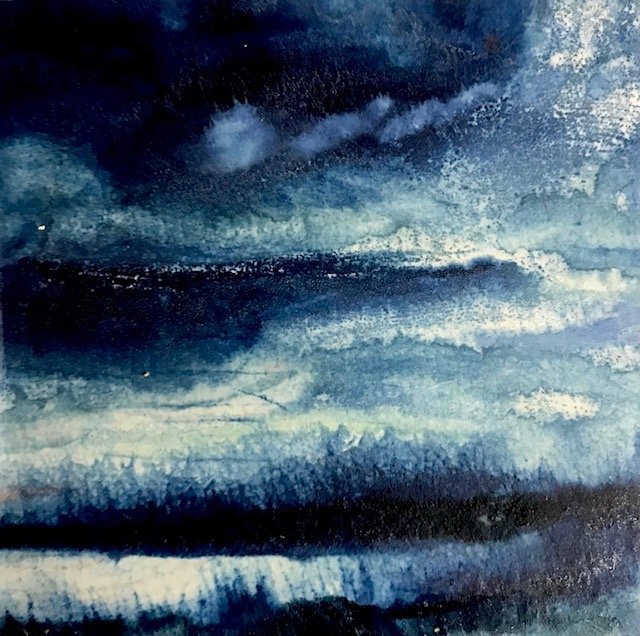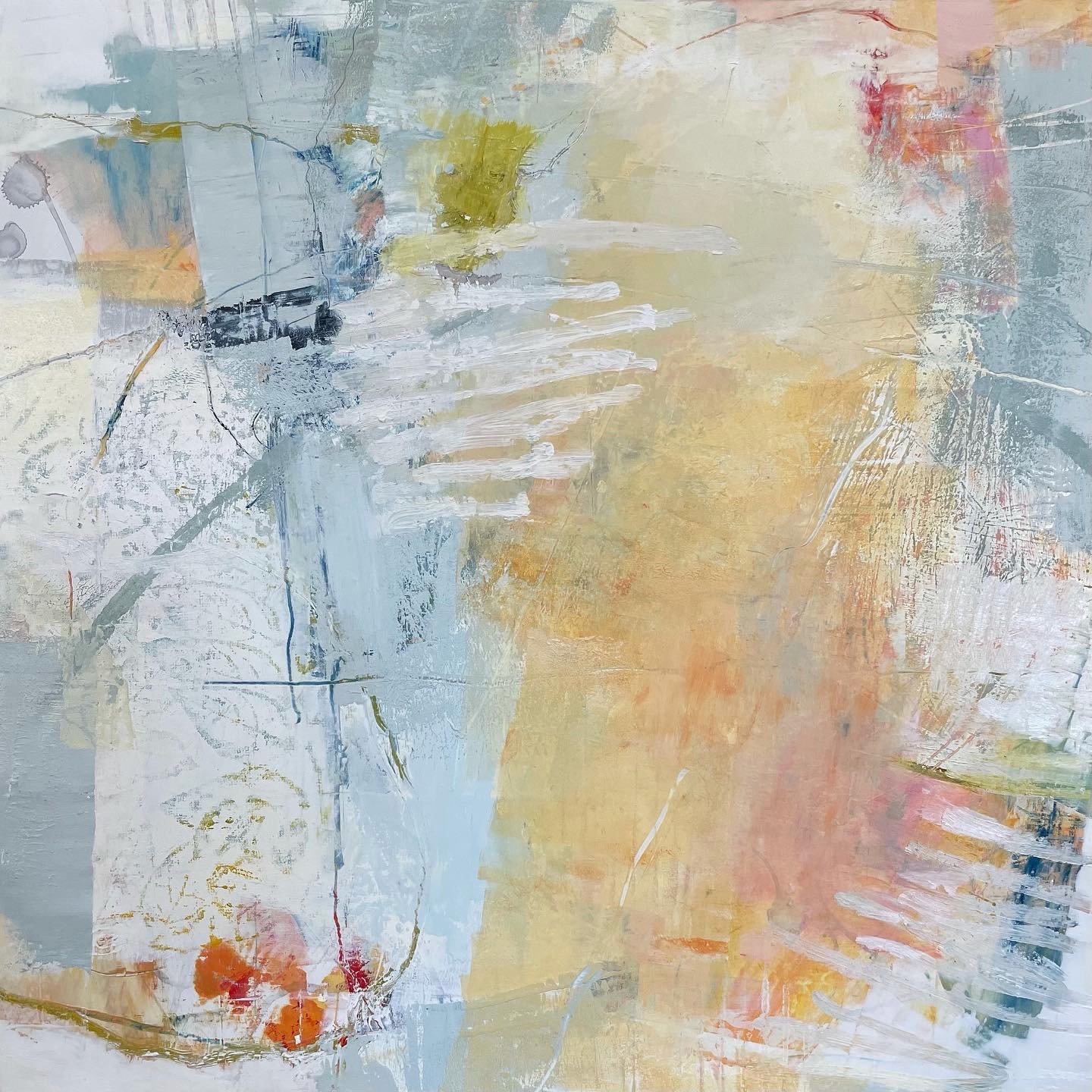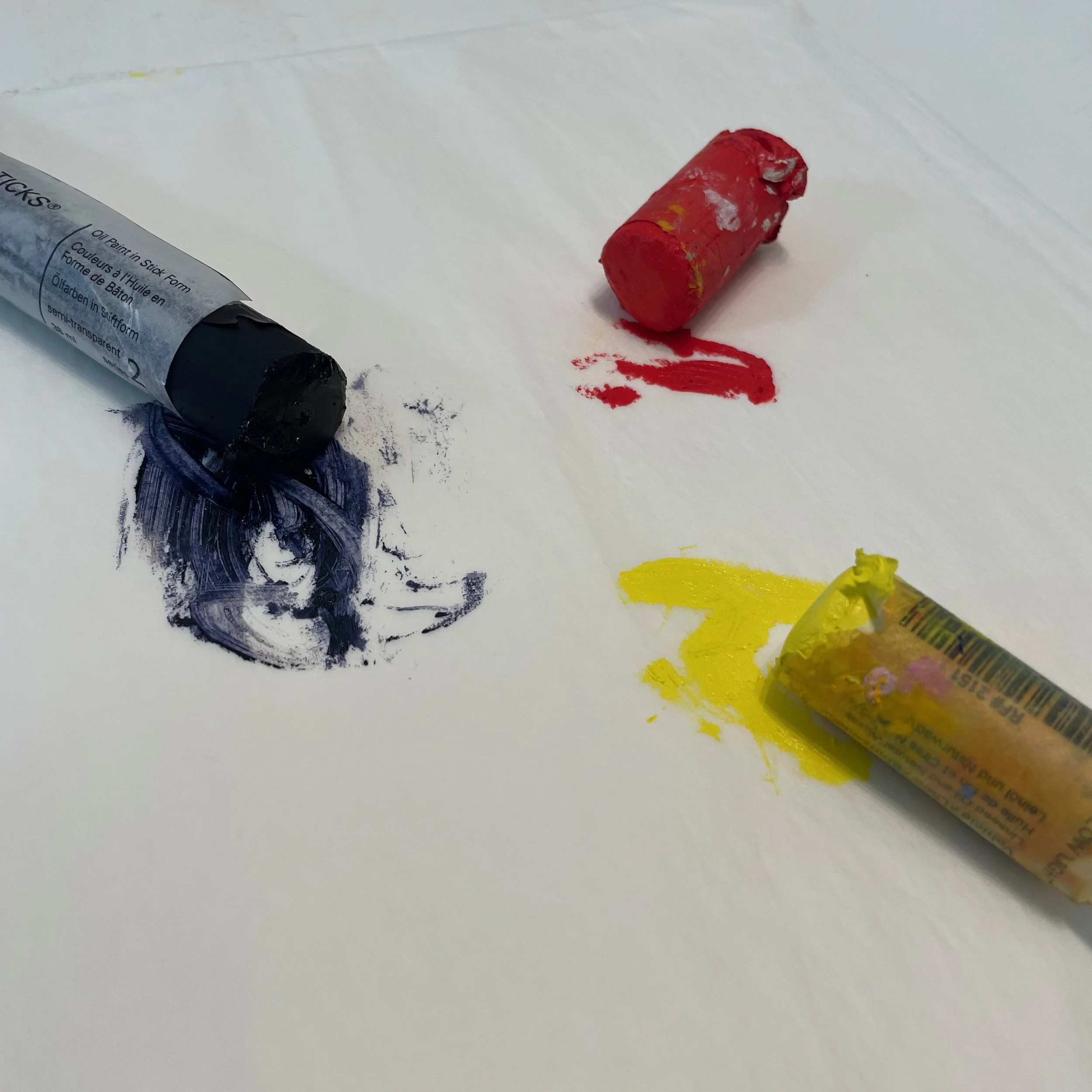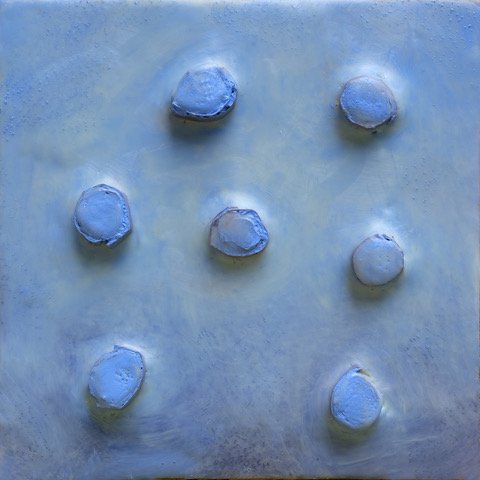Meet The Team: Dietlind Vander Schaaf
Our ongoing feature "Meet The Team" is our way of introducing you to the fine folks behind the scenes who make R&F possible. In this week’s installment, you will meet Dietlind Vander Schaaf. Dietlind has an MFA from the University of San Francisco and an MA from the University of Southern Maine. She has exhibited widely and her work has been featured in Maine Home + Design, Decor Maine, UPPERCASE, and Downeast magazines.
We are proud of all of our employees, from our paint-makers to the folks answering the phone and packing orders, and everyone in between. Our ongoing feature "Meet The Team" is our way of introducing you to the fine folks behind the scenes who make R&F possible. In this week’s installment, you will meet Dietlind Vander Schaaf.
Dietlind Vander Schaaf has an MFA from the University of San Francisco and an MA from the University of Southern Maine. She has exhibited widely and her work has been featured in Maine Home + Design, Decor Maine, UPPERCASE, and Downeast magazines.
Dietlind is a Core Instructor for R&F Handmade Paints, an Ampersand Ambassador, and the former president of New England Wax. She is an annual presenter at the International Encaustic Conference and has taught workshops throughout the country, including Haystack, Arrowmont, Castle Hill, Snow Farm, Penland, Maine College of Art, R&F, and internationally at Zijdelings in The Netherlands. The recipient of grants from the Maine Arts Commission and International Encaustic Artists, as well as a Tending Space Artist Fellowship from the Hemera Foundation, she is also a certified Kripalu yoga instructor with speciality training in meditation, advanced asana, Ayurveda, and pranayama.
Please tell us your job title and a brief description of what you do day to day at R&F.
I wear a bunch of different hats. I direct our Core and Tier Artist programs, oversee store demos, coordinate our paint donations, and work on special projects such as social media, email marketing, and writing for our blog. I update our various websites too. Last year I worked with artist Bettina Egli Sennhauser to build a German version of our website and this year I built one for our new rental and residency at Brown Pink. Oh, and I make our YouTube videos as well. :)
What I do day to day depends on what is most pressing, but it generally involves a lot of email and spreadsheets and problem solving. Sometimes filming in my studio or doing live virtual demos. I love my job. It allows me a ton of creative freedom and really suits me.
Dietlind in her studio in Westbrook, Maine where she films many of R&F’s YouTube videos.
How many years have you been working for R&F?
I began working for R&F in August 2018. I work remotely from my home in Maine. A few times a year I visit my colleagues in Kingston.
What do you do outside of work? Do you have an art background or related practice?
When I am not working, I can either be found in my studio painting or - this time of year - in my yard gardening. I also enjoy cross country skiing, reading, cooking, hiking, and practicing yoga. I teach encaustic painting, which often involves travel - another thing I love. And in September each year I offer a week-long encaustic retreat in Maine.
If someone came to visit Kingston, what's one thing you would recommend they see/ do/ eat/ experience?
I would definitely recommend the tacos at Diegos. They are very, very good. I’d also recommend a trip to Dia Beacon. It’s about 40 minutes from Kingston. Dia Beacon has an incredible collection of work from the 1960s to present. I had the opportunity to go with a bunch of folks from R&F in 2019 and I’d return in a heartbeat.
Favorite color in R&F's paint line?
This is a seriously hard question. I use a lot of blue in my work - Ultramarine Blue Pale and King’s Blue are go to colors for me. I think they are in nearly everything I paint. I am also partial to shades of gray, so Cerulean Grey and Turkey Umber Pale are top contenders too. And I am madly in love with our Ancient Gold. I’ve begun using it in my paintings in addition to 23 karat gold leaf.
But if I had to pick just one color, it would probably be Courbet Green. It’s so dark - we describe it as a green version of Indigo. Super earthy and a bit somber. I mix it with a small amount of Intense Carbon Black to create many of my underpaintings.
You can see more of Dietlind’s work on her website dietlindvanderschaaf.com or follow her on Instagram @dietlindvanderschaaf.
Meet The Team: Sean Noonan
In this “Meet The Team” post you will meet Sean Noonan. Sean was born in Brooklyn, New York and earned his BFA at Pratt Institute. His work has been shown in South Korea, Copenhagen, and London. Sean is R&F’s Education and Studio Coordinator.
We are proud of all of our employees, from our paint-makers to the folks answering the phone and packing orders, and everyone in between. Our ongoing feature "Meet The Team" is our way of introducing you to the fine folks behind the scenes who make R&F possible.
In this “Meet The Team” post you will meet Sean Noonan. Sean was born in Brooklyn, New York and earned his BFA at Pratt Institute. His work has been shown in South Korea, Copenhagen, and London. Sean is R&F’s Education and Studio Coordinator.
Please give us a brief description of what you do day to day at R&F.
Every day brings something new with the position, and that’s what I enjoy most. During our busy workshop season, I administrate and help host our workshops. I make sure students have the information they need to feel prepared prior to classes, during the workshop, and throughout their stay in Kingston.
When classes slow down, I develop the program for the following year, reaching out to artists and teachers with the intention of creating a well-rounded program. I try to spotlight new techniques and processes I hear about from teachers and peers, while expanding knowledge of our paint lines.
As a painter myself, I really enjoy being part of the conversation of art making, jumping in to answer tech questions, talking about art with my coworkers, and interacting with students about their work.
How many years have you been working for R&F?
It will be five years in August, time flies when you are having fun :)
What do you do outside of work? Do you have an art background or related practice?
I like to work on my house. It turned 100 this year so there is always something to do. I paint, garden, hang out with my wife, friends, and the dog. I have an education in painting and have taken regular art classes for most of my life. I try to paint a few times a week if possible.
If someone came to visit Kingston, what's one thing you would recommend they see/ do/ eat/ experience?
I would recommend they walk around the Rondout neighbohood. Plenty to see, eat, and take in all while getting a feel for Kingston’s lively past.
Favorite color in R&F's paint line?
This is always a hard question to answer. I think it may be easiest to give you my favorite color of the moment. I like to work over a colored ground, on found wood, and the wood often has existing layers of color from a previous life. Working with transparent colors and semi-transparent colors allows me to take advantage of the existing color underneath, while adding complexity.
So, at the moment, semi-transparent Green Earth is my go-to.
To see more of Sean’s work, visit his website pastthesun.com.
Meet The Team: Alyssa Gougoutris
n this “Meet The Team” post you will meet Alyssa Gougoutris. Alyssa is one of R&F’s paint-makers - that indispensable group of people behind the scenes trained to create each of the 103 different colors in our encaustic and Pigment Stick® lines.
She has also taken quite a few of our Instagram photos. You might remember her gorgeous pink nails that perfectly matched Dianthus Pink a few weeks back? That’s Alyssa.
We are proud of all of our employees, from our paintmakers to the folks answering the phone and packing orders, and everyone in between. Our "Meet The Team" feature is our way of introducing you to the fine folks behind the scenes who make R&F possible.
In this “Meet The Team” post you will meet Alyssa Gougoutris. Alyssa is one of R&F’s paint-makers - that indispensable group of people behind the scenes trained to create each of the 103 different colors in our encaustic and Pigment Stick® lines.
She has also taken quite a few of our Instagram photos. You might remember her gorgeous pink nails that perfectly matched Dianthus Pink a few weeks back? That’s Alyssa.
Please give us a brief description of what you do day to day at R&F.
My job title is paint-maker. I have different tasks depending on the day. About half of the week I am milling and the other half I am correcting and pouring into the molds.
I also have my assigned day for the pigment room, where I get suited up in my hazmat and combine pigment with either oil or wax. Usually, when I am done with my tasks in production, I'll head over to post-production to wrap and label paint.
How many years have you been working for R&F?
In December, it will be my 5 year anniversary with R&F! :)
What do you do outside of work?
Outside of work, I enjoy spending time with my family and my partner. Baking is one of my passions and I have my own small business (Tito's Treats). I love to teach art, and I am currently a teaching artist at The DRAW of Kingston. In my spare time, I like to draw, collage and experiment with new mediums (encaustic is my favorite by far).
Do you have an art background or related practice?
I earned my Associate of Science with a focus in Fine Arts at SUNY Ulster in 2015 and my BFA in printmaking in 2017 from SUNY New Paltz.
I was also a studio tech at the time, which was a great learning experience.
If someone came to visit Kingston, what's one thing you would recommend they see/ do/ eat/ experience?
If you come to Kingston, I recommend starting your day off with a bagel from Sunrise Bagels and Deli or a hot breakfast from Dietz stadium diner. After that I'd go for a walk at the Hutton brickyards and enjoy the scenery along the Hudson. For lunch, I recommend Urban Fork or Bun's Burgers, and then a walk through uptown to visit the record stores and boutiques.
If you want to stay uptown for dinner there's Vincenzo's Pizzeria, but if you'd like to enjoy the nightlife of downtown, Armadillo would be another great choice. If there's room after dinner, Ice cream from Mickey's Igloo hits the spot, or travel to Catskill or Hyde Park for a drive-in movie and some popcorn.
Favorite color in R&F's paint line?
Hard to pick just one! So maybe I can give my top three... Cerulean Grey, Jaune Brilliant, and Courbet Green.
Artist Spotlight: Lisa Pressman
Lisa Pressman works and teaches in a variety of mediums, among them oil, encaustic, cold wax, and mixed-media collage. Her work is abstract, conceptually based, and process-driven. It features marks, forms, colors, and patterns that are evocative rather than descriptive. A New Jersey native, Lisa received her Bachelor of Arts degree in fine art from Douglass College at Rutgers University in 1979 and her Master of Fine Arts degree in Painting from Bard College in 1981. Her work is represented by Susan Eley Fine Arts in New York, Addington Gallery in Chicago, and Slate in Telluride, Colorado.
Lisa Pressman, Stacks, 15” x 12”, Pigment Stick® on paper, 2019
Lisa Pressman works and teaches in a variety of mediums, among them oil, encaustic, cold wax, and mixed-media collage. Her work is abstract, conceptually based, and process-driven. It features marks, forms, colors, and patterns that are evocative rather than descriptive.
A New Jersey native, Lisa received her Bachelor of Arts degree in fine art from Douglass College at Rutgers University in 1979 and her Master of Fine Arts degree in Painting from Bard College in 1981. Her work is represented by Susan Eley Fine Arts in New York, Addington Gallery in Chicago, and Slate in Telluride, Colorado.
In addition to teaching at R&F, Lisa has served as faculty at the former Art Institute of NY, as well as a visiting professor at Pratt Institute and taught workshops in France, Mexico, and Italy.
Lisa Pressman, Thinking Patterns, 60” x 50”, clay, 1978
Can you tell us a little about yourself? How did you get your start as an artist?
I began thinking as an artist (though I didn’t realize it until later) when I went on a trip to Israel with my mother at the age of 12. The stark dualities of old and new, cultural and religious differences, the contrast in landscape and the relics, museums and religious sites stuck in my brain for a long time. The realization of the bigger world beyond my life in New Jersey was life changing.
At that time, I was writing in journals, experimenting with poetry, and I began doing ceramics. Working with clay was the game changer, much to the chagrin of my father who took me out to dinner before I started college and asked: “You sure you don’t want to be a doctor or a lawyer?”
I was quite sure. On the other hand, my mother was my greatest supporter, as she herself had a creative side acting, painting, and selling antiques.
Lisa Pressman, Outside In (side view), 48” x 12” wood and unfired clay, 1979
When I went to college my identity as an artist began to take shape. The first thing that happened was my ceramics professor told me to make sculpture: apparently my pots were very wonky. The second influence was the Women’s Artists Series started by Joan Snyder at Douglass College, which was the women’s school at Rutgers University.
Untitled installation, unfired clay and wood, 1979
In 1975 there were no women professors and this program brought in all the feminist artists of the day to lecture for us. It made it seem possible to actually pursue a career as a female artist. When the department brought in the painter Joan Semmel as a female professor, I began painting in her class.
It really was the positive feedback of all those teachers that had a huge impact on my identity as an artist. Later in graduate school for sculpture I became enamored with paint and color and haven’t look back… until recently.
Lisa Pressman, Messages 22, 12” x 12”, smoke, thread, Letraset, and ink, 2021
What are you currently working on in the studio? How has your work evolved over the years?
My work develops in a spiral with constant themes that get revisited in different ways and materials. Dualities of inside and outside, imagined internal spaces and rooms, mark-making as time-keeping, color explorations and materiality. From clay to oil paint, encaustic, cold wax, and now other materials, the work is always shifting, yet maintaining those underlying concepts.
Right now in the studio I have been working on paper and board with mixed media such as ink, smoke, fire, Letraset, RF Pigment Sticks, stitching and more. These works are called Messages and refer to rituals, portals, deconstruction, language and grief. I just finished an art book using those materials.
Collection of work from an installation in 2016 featuring cold wax, pastel, and oil on insulation.
What types of media do you like to work with? Do you go in search of your subjects or do they find you?
I really love experimenting with lots of media. I find that materials open up avenues and paths that bring new ideas and approaches to the work.
Although I do have common themes, playing with materials and not thinking is always positive for my work.
You will be teaching Focusing Your Visual Voice With Encaustic and Exploring Visual Language with R&F Pigment Sticks® this year. What do these workshops focus on and what can students expect to leave with? I'm particularly interested in how you help students explore, focus, and develop their visual language.
These workshops are focused on the materials and the myriad ways that artists can use them to play and experiment. In that mode of making, I find that the participant’s own point of view or interests reveal themselves. I use many prompts, both visual and written. Visual prompts get you out of your head and allow the essence of a visual language to unfold. Writing and words give a structure to each individual’s thinking/feeling about what they are doing. I find that list making, metaphors and talking about inspirations helps to focus a personal language. Also I have an intuitive and perceptive eye when I am teaching that facilitates these kinds of realizations.
(Please note: “Focusing Your Visual Voice with Encaustic” is sold out, but there is still space in “Exploring Visual Language with R&F Pigment Sticks®.” To learn more, visit rfpaints.com/workshops/exploring-visual-language.)
Lisa Pressman, Burning Ashes 2, 7” x 5”, mixed media, 2021
What keeps you motivated in the studio? What is your typical studio day like? What's next for you?
I always leave something to do in the studio. There are stations with materials and works in progress, so I can just walk in and decide what to do that day. Occasionally cleaning up or reorganizing can be a great a motivator. Lately I don’t have a typical day in the studio. Between teaching, my business with artist Sue Stover and life, my studio practice happens in starts and stops. If I get a few hours in the studio I can get a lot done. I never was a full-day studio artist anyway. I have figured out how to accept my practice as is and work within my own timing.
A show is planned in February at The Painting Center focused on the message pieces. I also have a big project in mind that will involve my work, my late son’s work, as well as the idea of what remains and sending messages to love ones lost. This has been brewing for a year or two. I see it as an installation, which is something I haven’t done in years, so prep work is on the table.
Lisa Pressman, New York State of Mind, 24” x 24”, encaustic on panel, 2018
Sue Stover and I started a teaching platform called C2C Art Projects, featuring our joint and individual classes, along with a C2C Art Collective last year. The Collective is an online, member-focused community center, which is an exciting new opportunity for artists, teachers, and anyone with a serious interest in art. We provide access to hundreds of resources, active and engaging conversations with fellow artist professionals, and connections to wider networks of creatives. In addition to teaching at R&F this year, I will also be teaching at Omega Institute for Holistic Studies, as well as in San Miguel, Mexico.
To learn more, visit lisapressman.net. You can follow her on Instagram @lisapressmanart.
From The Collection: Wayne Montecalvo
Wayne Montecalvo works with image and materials in order to push the confines of art making to reinvent, rather than reproduce an image. His process involves “allowing an idea to emerge organically through curiosity.” Through a manipulation of materials, he distorts and redefines an image, starting with the expected and ending with something mysterious. His approach is painterly; an effort to find a new way to encounter the familiar. R&F is proud to have a piece of Wayne’s work in our permanent collection.
Wayne Montecalvo, Karen Ballas, 24” x 15”, encaustic on panel, 2000. Permanent collection of R&F Handmade Paints.
Wayne Montecalvo works with image and materials in order to push the confines of art making to reinvent, rather than reproduce an image. His process involves “allowing an idea to emerge organically through curiosity.” Through a manipulation of materials, he distorts and redefines an image, starting with the expected and ending with something mysterious. His approach is painterly; an effort to find a new way to encounter the familiar. R&F is proud to have a piece of Wayne’s work in our permanent collection.
Artist Wayne Montecalvo
Wayne’s awards are many. He was an Awagami Artist-in-Residence at the Awagami Paper Factory in Tokushima, Japan and the recipient of two fellowship awards for residencies at the Vermont Studio Center in Johnson, Vermont. He was selected for two residencies at the Frans Masereel Zentrum voor Grafiek in Kasterlee, Belgium and served as a John Michael Kohler Foundation Arts/Industry Artist-in-Residence in Sheboygan, Wisconsin. In addition, Wayne was awarded a Women’s Studio Workshop Artists’ Fellowship. And that’s just to name a few.
Can you tell us a little bit about yourself? How did you get your start as an artist?
Calling oneself an artist sometimes seems a peculiar thing to me. I never had a moment when I decided to be an artist. I feel, as perhaps a lot of artists might, that it was a gradual development of something that might have already been in place.
As long as I can remember, even when I was young, I liked to make things up, invent things out of my head and draw them on paper. The desire to create something is always there. I’ve always been attracted to drawing, painting, and object making. And later as an adult, I developed a curious interest with musical instruments which I have integrated over the years here and there as part of my art making, especially in regard to video projects or sometimes performance events.
There were times when I thought I would stop “being an artist,” but sooner or later I found there was always something I needed to bring to fruition and would end up making an art piece of some type.
Wayne Montecalvo, First House, 24”x 33”, encaustic, digital images, and Japanese papers on panel, 2021.
What types of media do you like to work in?
I try to incorporate any media that will stretch my approach to art making. In addition to encaustic medium, I often include paint, India ink, dye, powdered graphite, stained surfaces, silkscreen prints, charcoal, as well as other mark making media such as wax crayons, colored pencils and various brands of drawing tools that sometimes contain other types of materials that might (but not always) work with wax.
I also use a lot of thin paper with most of my pieces. All of my digitally produced imagery is printed on very thin Japanese paper.
What are you currently working on in the studio and how has it evolved over the years?
I have been working with portraits for a while. Lately they have gotten much smaller and for the most part they are black and white. I am trying to make the subject unidentifiable using heavy splatter and powered graphite embedded in wax. The interest in using people as a subject matter came out of earlier artworks, short video pieces that involved volunteers willing to become characters and perform in various staged events with cheaply built backdrops and environments.
This led to using still images from those videos to make silkscreen prints, which later branched out into painting in a somewhat traditional approach. I started using encaustic paint along the way for some of these paintings that later spilled over into incorporating digital images with my art making.
Wayne Montecalvo, A Perfect Pear, 19”x 33”, encaustic, digital images, acrylic paint, and Japanese papers on panel, 2021
Do you go in search of your subjects or do they find you?
As far as choosing my subjects, I like to have some familiarity with the people I work with, and I usually ask people I already know. I like for there to be some history with a person, rather than someone I don’t know. Sometimes people like the idea, sometimes not. I think this has developed from previous efforts at making artwork by asking people to become a persona, or to become a character, often pushing the comfort zone and inviting people to temporarily become someone else.
I still question what I am doing, and I like to ponder the idea of using a real person’s identity and changing it somehow, especially in this age of immediate social network interaction. Is there a commitment to someone’s face or persona? Is there a responsibility on my part as an artist, or on their part as a model? Especially when considering that I am going to redefine, distort, or augment an image. But in the end, I like to think of it as a collaboration and that is a good thing.
Wayne Montecalvo, Do The Doo, 5.5”x 6.5”, encaustic, digital images, India ink, powdered graphite on board, 2022
You will be teaching "Layering Photo Based Imagery with Encaustic and Pigment Sticks" twice this year. What does this workshops focus on and what can students expect to leave with?
All of my workshops focus on modifying the subject of a photographic image into something new or unexpected. In my own work, I am constantly augmenting the composition using a host of techniques. I use physical manipulation to reshape digital images into something that is no longer a digital reproduction.
The workshops encourage students to deconstruct and then reconstruct into a new piece using things like tearing, re-arranging, disassembling, distressing, reversing, concealing and any number of additional methods that might include Ink, paint, powdered graphite, and layering images, to name a few.
Please share a bit about your piece in R&F's Permanent Collection.
The piece in the R&F collection is an older piece, which I am grateful to have in their collection. It was made during my early years of experimenting with R&F paints. And as most artists develop and learn what a material might allow, it is quite removed from what I am doing now.
Wayne Montecalvo teaching a workshop.
I was focused on yearbook images at the time, random faces, random people, typical settings. I was obsessed with the yearbook photographic style of capturing something seen as significant in the moment, and it seemed a logical source for subject matter.
But I also thought it was a funny picture and that it would be a good subject to place in a new setting. That idea has always stuck in my head and is still something I include in my work through distorting, overlapping, and altering the meaning of something (usually the theme is people).
What keeps you motivated in the studio? What is your typical studio day like? What's next for you?
Motivation for me is more of an urge that comes and goes, rather than a precise approach to making artwork. But it can also come from anywhere. I don’t like to force creativity, or feel compelled to produce something in the studio, but when I do make artwork it, is usually from a need to see an idea materialize.
A typical studio day might be stretching and exposing a silk screen, printing digital files for myself (and other artists), creating room in the studio to make more work, testing materials to use with encaustic, building a few panels, photographing artwork, that sort of thing.
In addition to teaching at R&F, what’s next for you?
I’ll be in Ireland at Essence of Mulranny from October 12 - 23 (as part of a two class workshop with Laura Moriarty) and in San Miguel, Mexico November 17 - 22.
To see more of Wayne’s work or learn about his international workshops, visit waynemontecalvo.com. To register for workshops at R&F, visit rfpaints.com/workshops.
Meet The Team: Luke Benicase
We are proud of all of our employees, from our paintmakers to the folks answering the phone and packing orders, and everyone in between. Over the next few months we will be sharing a feature called "Meet The Team" to introduce you to the fine folks behind the scenes who make R&F possible.
We kick off our inaugural “Meet The Team” post with one of our newest employees - Luke Benicase. Luke grew up and attended school through the 12th grade in Kingston, before going on to SUNY Ulster and SUNY New Paltz.
Luke Benicase at work in post-production at R&F.
We are proud of all of our employees, from our paintmakers to the folks answering the phone and packing orders, and everyone in between. Over the next few months we will be sharing a feature called "Meet The Team" to introduce you to the fine folks behind the scenes who make R&F possible.
We kick off our inaugural “Meet The Team” post with one of our newest employees - Luke Benicase. Luke grew up and attended school through the 12th grade in Kingston, before going on to SUNY Ulster and SUNY New Paltz.
Please tell us your job title and a brief description of what you do day to day at R&F.
I am a part of post production. I wrap Pigment Sticks® and encaustic paint, occasionally assist with shrink wrap, and I also help with boxing and shipping orders.
How many years have you been working for R&F?
I just started this year, and I’m looking forward to being here a long time. R&F is very easily the best job I've ever had.
What do you do outside of work? Do you have an art background or related practice?
Outside of work If I'm not working on any drawings or paintings, I like watching movies or going for a hike and getting together with friends.
Artwork credit: Luke Benicase
Artwork credit: Luke Benicase
If someone came to visit Kingston, what's one thing you would recommend they see/ do/ eat/ experience?
For anyone visiting Kingston I'd recommend that they take a walk through all the streets uptown to see all the artwork on the buildings.
Artwork credit: Luke Benicase
Favorite color in R&F's paint line?
My favorite color at R&F is Cerulean Grey. Every time I pick it for an order I always want to use it for a background for a painting!
You can follow Luke on Instagram at @lben_art.
The Diptych Project: Transatlantic Fusion at The International Encaustic Conference
New England Wax is a professional organization that connects artists in New England who work in encaustic, providing opportunities to exhibit, to share technical information and aesthetic ideas, and to build friendships with other artists. European Encaustic Artists is a group designed to raise awareness and share resources about encaustic painting in countries throughout Europe.
The idea for this project grew out of a desire to expand international creative collaboration between artists, due to the social isolation imposed by the pandemic. Building on two previous diptych projects by members of New England Wax, artists from six different countries got together to participate in this project, meeting virtually. Fifty-six artists were randomly paired between the groups.
Image credit: Deborah Peeples, Capriccio, encaustic on panel and Joanna Kidney, Jostle, encaustic on panel.
As part of the 15th International Encaustic Conference this year, members from New England Wax (N.E.W.) and European Encaustic Artists (E.E.A.) have put together exhibition titled The Diptych Project: Transatlantic Fusion.
New England Wax is a professional organization that connects artists in New England who work in encaustic, providing opportunities to exhibit, to share technical information and aesthetic ideas, and to build friendships with other artists. European Encaustic Artists is a group designed to raise awareness and share resources about encaustic painting in countries throughout Europe.
The idea for this project grew out of a desire to expand international creative collaboration between artists, due to the social isolation imposed by the pandemic. Building on two previous diptych projects by members of New England Wax, artists from six different countries got together to participate in this project, meeting virtually. Fifty-six artists were randomly paired between the groups.
Anne Curran, We are All in the One Map, rice paper and mixed media collage and encaustic and Charyl Weissbach, Connectedness, encaustic on paper on panel.
Each artist initiated a diptych by painting a panel and then sending a high-resolution image and a statement about that work to their partner. Diptych partners responded by creating a second panel in any manner they chose. Partners agreed between themselves as to edge treatment and orientation of the finished pairs. The resulting works show a wide range of styles, techniques, and cross-cultural interpretations
As Bettina Egli Sennhauser, founder of E.E.A., put it, “I hope that the wide variety of works in our project and exhibition will inspire viewers; help overcome language barriers; encourage the dialog between artists on both continents; and build new, sustainable friendships.”
The exhibition will take place at The Commons in Provincetown, Massachusetts from June 1 -11, 2022 with an opening reception on Friday, June 3 from 5 - 8 pm. A printed catalog will be available and a future exhibition in Basel, Switzerland is planned.
It’s not too late to register for the 15th International Encaustic Conference. The conference takes place June 3 - 5th in Provincetown, Massachusetts. It features a keynote speaker, demos and talks on all sorts of topics related to encaustic, a vendor room, a postcard show, a hotel fair, and more. To sign up, visit castlehill.org.
There is also room in a few pre and post conference workshops, including:
5/31 - 6/2: Adapting Processes: The Fusion of Encaustic & Fabric with Susan Stover
Explore the possibilities of adapting tools and processes to use them in a contemporary way. The workshop will start by making some of our own tools based on traditional ones used in the production of textiles. Participants will use these tools to create lines, shapes, motifs, and repetitive mark-making on silk to produce unique fabrics that will be embedded into encaustic. We will also use these tools directly with the encaustic process. Learn more here.
6/8 - 9: Value Does the Work, Color Has the Party with Kelly Milukas
This color primer workshop is designed to take you from gray scale value mapping to luminous color clarity. Create an abstract composition or distill a scene into large masses, group similar values together for strong designs. See past surface details to a simplified pattern of lights and darks, and value shapes. Working with handmade value scale tools, Kelly will demonstrate the concepts, students will gain a greater under-standing of values translated into colors that can then be applied to any medium. Learn more here.
6/8 - 9: The Light Touch (online) with Joanna Kidney
Would you like to develop a more intuitive, experimental approach with your work? Accessing intuitive modes of working brings about a fine tuning of the visual voice. This workshop will be hands on, using prompts, exercises and practices to nurture experimentation and intuitiveness in the studio. We will draw, paint, write and look at other artists work to support the explored ideas. Learn more here.
6/8 - 9: Material World: Wool & Wax with Susan Lasch Krevitt
Open to all skill levels, this workshop will introduce techniques for creating 2-D and 3-D artwork using wool and encaustic. We will cut, fold, wrinkle, pierce and weave with wool. Both new and repurposed woven, knitted and unspun wool will be available for use. Alternative hanging solutions for sculptural wall hung work will be provided. Learn more here.
6/8 - 9: Where Wax Meets Print with Elise Wagner
Encaustic collagraph printmaking uses wax in place of collage materials on the printing plate. Elise will demonstrate how she marries the tools and techniques of these two age old mediums — encaustic painting and intaglio printmaking, to create prints on paper. These prints are full of depth and achieved by exploiting the embossed, incised and textural marks common to encaustic that we all so adore about the medium. Learn more here.
Color Mixing with Jeff Hirst, Jodi Reeb, & Lorraine Glessner
We continue our series on color mixing with recommendations from instructors Jeff Hirst, Jodi Reeb, and Lorraine Glessner. (If you missed our previous color mixing posts, go back and check out Color Mixing with Debra Claffey and Susan Stover or Color Mixing with Julie Snidle and Dietlind Vander Schaaf.)
This week Jeff illustrates how he creates cool and warm chromatic grays. Jodi shares how she makes a variation on orange for her circle paintings. And Lorraine explains the way she creates the range of whites that can be found in her monoprints.
We continue our series on color mixing with recommendations from instructors Jeff Hirst, Jodi Reeb, and Lorraine Glessner. (If you missed our previous color mixing posts, go back and check out Color Mixing with Debra Claffey and Susan Stover or Color Mixing with Julie Snidle and Dietlind Vander Schaaf.)
This week Jeff illustrates how he creates cool and warm chromatic grays. Jodi shares how she makes a variation on orange for her circle paintings. And Lorraine explains the way she creates the range of whites that can be found in her monoprints.
Enjoy. Feel free to tag us with photos of your color mixes on Instagram using the hashtag #rfpaints. We’ll share as many as we can in stories.
Jeff Hirst
“I often use chromatic grays in my work to play against more vibrant muted and prismatic color. For me, there’s a fine line between a muted tone and chromatic grays. I mix my grays using three primaries because I respond to the rich tonal qualities that I can get without using black.
To make the grays I use R&F Cadmium Yellow Medium, Cadmium Red Medium, and Ultramarine mixed with Titanium White. It’s a basic color mix but covers a wide tonal range that includes warm and cool grays.
I also use large amounts of encaustic medium with my grays (and other colors) to accentuate the luminosity of the encaustic. Often, I use vibrant underpainting to counter chromatic grays and muted tones with many layers of paint.”
Jeff Hirst’s color notes for mixing warm opaque and transparent chromatic grays.
Jeff Hirst’s color notes for mixing cool opaque and transparent chromatic grays.
Jeff Hirst, Subliminal Archetype, 27” x 26”, encaustic on shaped panel.
Jeff will be teaching Exploring Color with Encaustic August 8 - 10 at Grand Marais Art Colony in Grand Marais, Minnesota. This three-day workshop covers complex color relationships including chromatic grays, muted tones, and prismatic color; opaque and transparent surface; alternative fusing techniques; using complementary color surface manipulations and more.
To learn more, visit grandmaraisartcolony.org.
Jodi Reeb, encaustic and metallic paint on acrylic panels, 39" x 78" x 2", 2022.
Jodi Reeb
“My favorite color-mix is what I call "pumpkin" and consists of four colors: Cadmium Orange, Mars Yellow Light, Brilliant Yellow Extra Pale, and Burnt Umber. This mix creates a subdued orange hue to give my circular paintings a pop of color when Cadmium Orange is too bright. I love the range of blues and greens that R&F Handmade Paint offers and adding a warm color to the series provides a nice accent.
My color mixing proportions are 65% Cadmium Orange, 20% Mars Yellow Light, 10% Brilliant Yellow Extra Pale and 5% (a smidge) Burnt Umber. You can see the resulting color in the collection above. The ‘pumpkin’ painting is on the right, top-layered under the emerald green disk.”
June 24 - 26, Jodi will be teaching Encaustic with Photo Collage at Wild Rice Retreat Center in Bayfield, Wisconsin. This workshop covers creating translucent, layered paintings using photographs printed on light-weight tissue paper and embedded in encaustic medium and paint.
An overview of a variety of techniques will be demonstrated such as image transfers, mixing your own paint, creating texture and working with masks and stencils. To learn more, visit wildriceretreat.com.
Lorraine Glessner, God's Eyes, encaustic monoprint on masa paper, 21.5” x 15.5” (shows Titanium/Neutral/Brilliant Yellow Extra Pale Mix)
Lorraine Glessner, Hope (detail), encaustic monoprint on masa paper, 21.5” x 15.5” (shows all 3 color mixes)
Lorraine Glessner
Over the past year, I found myself turning away from the brighter colors I had been using and reaching for the whites, grays and earth tones. I rarely, if ever, use color ‘straight out of the tube.’ My colors are always made up of 2 - 5 colors and I encourage my students to do the same. Mixing your own colors allows for a more personalized palette and ultimately, a more personalized body of work.
One color mix that I have used since I started painting in encaustic twenty years ago is Titanium White and Neutral White. For me, Titanium can cast blue in certain lights and appear too harsh. I soften Titanium with about 20% - 35% Neutral White for a bright white that almost reads like a Zinc White. If I want to go for an even more neutral/grayer white, add just a touch (about 5 - 10%) of Unbleached Titanium. If this is too gray for you and you prefer a softer, brighter white with a little flair, add about 5 - 10% of Brilliant Yellow Extra Pale to your original Titanium/Neutral White mix.
Lorraine will co-teach Exploring Landscape Through Photography, The Figure, & Encaustic: An Artist’s Retreat with Leah MacDonald July 11 - 15 at Lareau Farm and Inn in Waitsfield, Vermont. Utilizing the natural luminosity, textural and layering possibilities of encaustic, participants will experiment with photographic imagery, collage and marks to depict the spirit and essence of the land.
To learn more visit lorraineglessner.wordpress.com.
Color Lines, Resources, etc.
Remember you can view both our full Pigment Stick color line and encaustic color line on our website. You can also download a color chart or our Teaching Artist list from our Resources page or locate a retailer who carries our products near you on our Store Finder. Be sure to subscribe to our channel on YouTube so you never miss a new video. (And thanks for all those likes and nice comments. We sure appreciate them.)
Enjoy. And keep painting.
R&F's Iridescent Color Line
R&F Handmade Paints makes eight iridescent paints, all of which are available in both our encaustic and Pigment Stick color lines®. If you haven’t begun exploring these yet, you are missing out.
When working with our iridescent color line, we recommend not extending them with much medium as that will tamp down the iridescence slightly. Designed to be standalone favorites, each of our metallic colors can be added to our transparent paints to create unique richly luminous colors.
R&F Handmade Paints makes eight iridescent paints, all of which are available in both our encaustic and Pigment Stick color lines®. If you haven’t begun exploring these yet, you are missing out.
When working with our iridescent color line, we recommend not extending them with much medium as that will tamp down the iridescence slightly. Designed to be standalone favorites, each of our metallic colors can be added to our transparent paints to create unique richly luminous colors.
Our metallic paints can also be added to opaque colors to add sheen and push color in cooler directions (with either Iridescent Silver, Iridescent German Silver, or Iridescent Pewter) or to provide a warm glow (with Ancient Gold, Iridescent Gold, and Iridescent brass). Iridescent Copper will change color more significantly, while Iridescent Pearl gives you a lovely metallic effect without impacting color.
Check out our newest video on YouTube (link below) to get a feel for how each of our metallic encaustic colors stack up against one another. While you’re there, don’t forget to like and comment on our demo videos, and be sure to subscribe to our YouTube channel so you don’t miss any of our future videos.
Ancient Gold: A boldly metallic iridescent gold that demands its own space.
Pigment Stick Drying Rate: Slow
Classification: Synthetic Inorganic
Chemical Composition: metal oxides on mica
Iridescent Copper: It works beautifully with Mars Red since Copper is an iridescent version.
Pigment Stick Drying Rate: Medium
Classification: Synthetic Inorganic
Chemical Composition: metal oxides on mica
Iridescent Gold: Warmer and deeper than Brass, but with less green-yellow than Ancient Gold.
Pigment Stick Drying Rate: Slow
Classification: Synthetic Inorganic
Chemical Composition: metal oxides on mica
Iridescent Pewter: A dark bluish-grey metallic.
Pigment Stick Drying Rate: Slow
Classification: Synthetic Inorganic
Chemical Composition: metal oxides on mica
Iridescent Brass: Cool, light, and yellowish with a hint of sheen and shimmer.
Pigment Stick Drying Rate: Slow
Classification: Synthetic Inorganic
Chemical Composition: metal oxides on mica
Iridescent German Silver: A warm deep silver, lighter than Pewter, but darker then Silver.
Pigment Stick Drying Rate: Slow
Classification: Synthetic Inorganic
Chemical Composition: metal oxides on mica
Iridescent Pearl: Has the look of crushed pearls. Adds iridescence without color to other paints.
Pigment Stick Drying Rate: Slow
Classification: Synthetic Inorganic
Chemical Composition: metal oxides on mica
Iridescent Silver: A richly warm antique silver.
Pigment Stick Drying Rate: Slow
Classification: Synthetic Inorganic
Chemical Composition: metal oxides on mica
Dietlind Vander Schaaf, Seerose, 30” x 30”, encaustic, Pigment Stick, metallic foil, and 23 karat gold leaf on panel, 2022.
Dietlind Vander Schaaf uses both real 23 karat gold leaf and R&F’s Ancient Gold encaustic paint to achieve richly reflective surfaces in her paintings, such as Seerose.
Lorraine Glessner, Vermont Views: Blues #4, 9.5” x 13”, encaustic monoprint on rice paper, 2022
Lorraine Glessner enjoys working with Ancient Gold in combination with Cobalt Blue for monoprints.
Leslie Giuiani, Caterpiggle, embroidery on encaustic painting on Encausticflex, 10” x 8”.
Leslie Giuliani creates iridescent backgrounds using our metallic color line. She has two great demo videos on YouTube showing how you can achieve silver leaf effects and gold leaf effects.
From The Collection: Laura Moriarty
Artist Laura Moriarty makes process-driven 2D and 3D works with encaustic whose forms, colors, textures, and patterns result from processes similar to those that shape and reshape the earth: heating and cooling, erosion, subduction, friction, enfolding, weathering, slippage.
Laura Moriarty, Trench, encaustic on red maple slab, 16.5” x 31”, 2001. Permanent collection of R&F Handmade Paints.
Artist Laura Moriarty makes process-driven 2D and 3D works with encaustic whose forms, colors, textures, and patterns result from processes similar to those that shape and reshape the earth: heating and cooling, erosion, subduction, friction, enfolding, weathering, slippage.
Artist Laura Moriarty in her studio.
The recipient of an Adolph & Esther Gottlieb Foundation Individual Support Grant, the MARK 09 Award from the New York Foundation for the Arts, and a Pollock-Krasner Foundation Grant, Laura has had many solo exhibitions at venues ranging from the Hunterdon Museum of Art to Kenise Barnes Fine Art. She has participated in a number of artist residencies, including at international locations such as Iceland, Belgium, and Germany. In 2012, she published Table of Contents, which she describes as “an artist's book in the fanciful guise of a geology textbook.”
Laura’s work is in the permanent collections of Coutts Bank in London; The Art Bank, a program of the US Department of State; and the Progressive Art Collection, among others. R&F is proud to have two pieces of Laura’s work in our permanent collection.
Laura Moriarty, Hive, encaustic, 20” x 17” x 4”, 2020
Can you tell us a little bit about yourself? How did you get your start as an artist?
It is difficult to pinpoint a start because I always had this idea of myself as an artist - I mean like, way before I had a body of work to speak of. When I was in my 20's I took painting classes once a week in the studio of an artist who lived outside of Woodstock named Franklin Alexander. He took an interest in me and gave me some badly needed clues, one of which was to find myself a community of other artists, and that is how I wound up working at Women's Studio Workshop for more than ten years.
The studios at WSW were such a great place to experiment, like a big think tank. I would say that's where eventually I started making somewhat coherent work, showing, and finding opportunities.
Laura Moriarty, Implement 3, encaustic, 7” x 4.5” x 3”, 2020.
What types of media do you like to work in?
The swirly types: papermaking, printmaking, encaustic, Suminagashi.
What are you currently working on in the studio and how has it evolved over the years?
I go back and forth in the studio, working on encaustic sculptures and monotypes. There is an ebb and flow to the studio process these days, sometimes building up, sometimes spreading out. Very fluid. There is always a further place where things can be pushed and pulled.
Laura Moriarty, Concentrations, encaustic, 11.5” x 9.25” x 3.75”, 2020.
You will be teaching A Process of Natural Wonder this summer at R&F, as well as Encaustic & Paper in September. What will these two workshops focus on and what can students expect to leave with?
I developed A Process of Natural Wonder as a workshop for fellow naturalists and experimenters. In this workshop, we take an archaeological approach to working with encaustic, with lots of embedding, digging and scraping. It's a very hands-on workshop where students can expect to come away with a collection of curious artifacts. Students who are already exploring sculptural encaustic find their own direction in this class because it gives them techniques they were craving, and I encourage that. We usually get to see some surprises and it's always a very fun class.
Encaustic & Paper is a workshop that emphasizes the beautiful, often translucent interplay of paper and wax. This is a great workshop for practicing artists who have an idea for a new series involving encaustic and paper, but would benefit from some feedback, material suggestions and/or technical guidance. It is also perfect for artists who need some time to experiment with different papers and techniques, and want to see demonstrations. This is a very hands-on workshop and Awagami Factory generously provides us with some amazing papers to try.
Laura Moriarty, Ex Uno Plures, encaustic on paper, 35.5” x 25.5”, 2020.
Laura Moriarty, Green Acres, encaustic on red maple slab, 30” x 20”, 2000. Permanent collection of R&F Handmade Paints.
Please share a bit about your two pieces in R&F's Permanent Collection.
Ah, My lumber phase! I made them both in my old rented barn studio. I was looking at aerial photographs as references for these, puzzling over how to layer the colors. I loved painting on slabs. They were rough and the wax would stiffen along the peaks - a scraper's delight!
What keeps you motivated in the studio? What is your typical studio day like? What's next for you?
These aren't fun times, and I fall in and out of slumps, but I am motivated to try to bring more wonder and beauty into the world - it feels like there is an opening for it. A typical week in the studio means a mix of me working on new pieces, sometimes there's a virtual meeting with a gallerist or collector, and sometimes I am documenting work or creating video content. And I have preparations as I am beginning to get back to teaching.
Next for me is an installation of some very long encaustic scrolls and some sumi ink drawings at Albany International Airport. And I am looking forward to an artist's residency at Cill Rialaig in Ireland next year.
To see more of Laura’s work, visit lauramoriarty.com. To register for workshops at R&F, visit rfpaints.com/workshops.
International Workshops: Lyn Kirkland & Julie Ann Wrathall
This week - in keeping with our ongoing international focus - we highlight two UK artists who teach encaustic painting. This might be of interest if you live in the region, are planning a trip to the area and want to tack on a workshop, or even if you are just looking to escape for a moment and travel vicariously. Lyn Kirkland and Julie Ann Wrathall share a bit about their backgrounds and teaching in their own words below.
Artist and teacher Lyn Kirkland at the entrance to her studio. Lyn recently represented R&F in an instruction video for Jackson’s Art, one of the UK’s largest art suppliers.
This week - in keeping with our ongoing international focus - we highlight two UK artists who teach encaustic painting. This might be of interest if you live in the region, are planning a trip to the area and want to tack on a workshop, or even if you are just looking to escape for a moment and travel vicariously. Lyn Kirkland and Julie Ann Wrathall share a bit about their backgrounds and teaching in their own words below.
LYN KIRKLAND
I grew up in the Midlands, about as far away from the coast as you can get in England, and my early artistic inspiration came from the likes of J.M.W Turner, his seascapes in particular. I never imagined that one day I would be living on the Isle of Portland on the Jurassic Coast of Dorset in the UK. I have always painted, sketched, created, but like a lot of us (of a certain vintage) was told when I left school that there were no prospects for artists, so I pursued a career in IT Marketing with IBM (UK).
After my youngest son was diagnosed with leukemia, I needed an outlet to stay sane. I pursued a diploma in Art, Design, and Media at a local college. My study focused on the merging of art and science, which culminated in a 3D wax piece called Chimerism (image above). Using wax was a revelation, a full sensory experience, and got me on the road to painting with encaustic.
The island environment of Portland offers much in the way of inspiration. From the geology and history, fossils, abandoned and working stone quarries (Sir Christopher Wren chose Portland stone to rebuild the City of London after the Great Fire in 1666), to the wild seas, hidden coves and folklore. My current work is focused on the sparse trees on the Island, and was inspired by the work of Regina B. Quinn.
Studio space is at a premium on Portland. I was lucky enough to secure a studio that sits in a courtyard behind an old school. It is home to a ceramicist, jeweler, printmaker, woodcarver, and film-maker. Such a fabulous environment, fizzing with creativity.
I offer one-on-one and small group instruction, and am currently mentoring one of my previous students who obtained Arts Council funding to support her emergence as an encaustic painter.
Last year I took part in a project with New England Wax and the European Encaustic Artists group called Transatlantic Fusing 21. Work from this project will be on view as part of the International Encaustic Conference this year.
Visit lynkirklandart.artweb.com to learn more and find out about upcoming classes.
Artist and instructor Julie Wrathall in her studio.
JULIE ANN WRATHALL
I live in Hertfordshire in the UK, (about 40 minutes NW of London) although I’m currently in the process of moving back to Cornwall, where I grew up. I’m a self taught artist; I drew, painted, and created non-stop as a child. When I became a teenager, art was deemed to be a hobby, and I subsequently worked in office and project management roles. I eventually found my way back in 2011, when I joined an art group that offered me encouragement and direction.
I've been working in the arts full time since 2012. After entering an art competition in September 2011 in which I won a place on a project at Tate Modern, I had the confidence to take my art more seriously. It gave me the push to quit my job and get an art studio.
I started encaustic with the lower heat wax, iron, and paper style, as that's all I'd seen. Then I came across a YouTube video with Patricia Baldwin Seggebruch setting fire to an encaustic panel with shellac on it, which I found exciting. I e-mailed Patricia, who was really helpful, and bought her books. I also attended a portrait master class in London with Lora Murphy in 2016. After a lot of testing and research, I started to introduce the wax and dammar workshops to my studio offerings as well.
I rarely work in other mediums now; I love encaustic too much to move back to pastels, watercolours, or oils, although I enjoy introducing those mediums into my encaustic work in mixed media styles.
I love having students in my studio. Watching the wax melt, helping them find the materials they need, giving them the confidence to go it alone, drinking tea, laughing, and sharing time together makes for a truly exceptional experience.
I have a lot of information on my website www.artyheaven.com. My current workshop offers are either via my online courses or 1-1 sessions over Zoom at this time. I will announce in person workshops once I'm settled in Cornwall.
Artist Spotlight: Sharon Paster
Bay Area artist Sharon Paster’s work reflects her attraction to the energy around her, “the force of a pounding surf, the motion of cars on a highway, the blink of an eye, the way objects in space talk to one another.” Her colorful oil paintings are an effort to suspend time, capturing movement and change.
Bay Area artist Sharon Paster’s work reflects her attraction to the energy around her, “the force of a pounding surf, the motion of cars on a highway, the blink of an eye, the way objects in space talk to one another.” Her colorful oil paintings are an effort to suspend time, capturing movement and change.
Sharon has exhibited in numerous group and solo shows—including San Francisco’s de Young Museum, the Marin Museum of Contemporary Art, the San Jose Institute of Contemporary Art and the Sonoma Valley Museum of Art. Her work has been included in Art of Northern California, the Serena & Lily Catalog, Luxe Magazine, Marin Magazine and San Francisco Magazine. She is on the ICB (Industrial Center Building) Art Association’s Board of Directors and her work is represented by a number of galleries in the Bay Area, as well as Boston, Tampa, and South Florida.
Tell us a little bit about yourself. You began painting early, and majored in art, but then moved on to a career in high tech marketing communications before returning to painting. What drew you back?
I began volunteering in the kindergarten art classes to stay involved with my kids, who are both now in their thirties. One day, I also happened to walk by the San Francisco Art Institute where the windows were open at the sidewalk’s basement level. I think it was the smell of turpentine that finally did it.
I stopped painting after college because I was very dissatisfied with my work. The smell and the lack of inhibition in children were what made me realize that art-making could be fun, it didn’t have to be “great.” So, I went back to the local community college in Marin to take classes. There I found so many like-minded people—professional artists as well as non-professionals—and just became part of the tribe. I stayed there taking courses in painting, drawing and sculpture with fantastic teachers for so many years, I got kicked out.
Sharon Paster, Intermission, 36” x 36”, oil on canvas.
How does life in northern California contribute to the themes or energy present in your work?
Not to make anyone feel bad about where they live, but the Bay Area is one of the most creative places in the world. There are tons of artists, writers, musicians, and designers of all stripes here. People are very open-minded. The weather is relatively mild, the coastal scenery is spectacular, and outdoor activity is part of the culture.
When I began painting again after a long hiatus, one of my first subjects was a pair of black shoes positioned in various conversational ways. I noticed the Marin hillsides here offered the same subject matter, with little conversations happening between bushes and various densities of shrubs. After a while, when I tired of the landscape horizon, I looked down and found the same energy between rocks— particularly between rocks at the water’s edge—as well as the energy between layers of the water itself. I started working more abstractly, going back and forth between representation and abstraction, and trying to get them to merge on various levels.
Sharon Paster, Diving In, 72” x 60”, oil on canvas.
Have you always worked in oil?
I began private painting lessons in oil at the age of 14. My grandfather painted in his Bronx basement in New York and I remember holding a loaded brush at a ridiculously early age, but we moved to Southern California when I was 5 and that was the end of that.
I was an oil painter in college in New England, but of course took printmaking and sculpture classes as well, and played with oil pastels all the time, drawing these cartoony faces and layering the colors. (I still can’t find one lipstick that works for me. I layer three at the same time.) I never learned how to work with acrylics. Since I loved the feel and smell of oils, I wasn’t motivated to learn water-based media at all. And watercolor just killed me, probably because I couldn’t control the layering.
What does your studio look like? What is a typical studio day like?
I have absolutely the best studio, in the best artist building in the Bay Area—what else can I say? My first studio was behind my house in Marin, and it was fine, especially when I was still connected with the college community.
When we were selling the house I knew I had to find space, and I was aware of the ICB Building in Sausalito, with about 100 working artist studios. I and was fortunate to find a closet-sized studio as a subtenant of Katy Kuhn, a fantastic and generous abstract artist.
My space eventually grew by knocking down a wall, and then a few years ago I got a chance to take over a corner studio on the top 3rd floor, overlooking the water. It’s quite large and the view is inspirational, but it took me awhile to get used to being in a huge space with so much light. For about 6 months, I couldn’t judge my work, everything was so foreign. Now I just try to focus on the wall where I work, and look out the windows only when I’m at a loss for color ideas or spatial cues.
In addition to working wall space, I have a gallery to hang paintings and other areas for storage, and use the studio for crits and artist meetings.
Studio view.
Sharon Paster, Eight Ball, 60” x 60”, oil on canvas.
On a typical day when I’m not traveling, I exercise in the morning, cross off things on my to-do list, and get to the studio around 11am. My prior studios never had a comfortable place to sit, so focusing for 2 - 3 hours worked great. Now I can stay 4 - 5 hours without losing it.
I’m also co-president of the ICB Artists Association (after being on the board for 6 years), which has over 80 members in the building, so I like to meet with other artists, and socialize or help plan activities, to foster more learning opportunities for all of us. So, I guess I’d have to say my favorite thing about my studio is a toss-up between the space and the amazing people I’m surrounded with.
How has your work shifted over the years? What interests you now?
I still go back and forth between representation and abstraction, looking for that sweet spot where I can offer a hook to the viewer without totally defining what they’re seeing. A recent studio visitor asked me what I’m focusing on, and I responded by saying “rocks, landscapes, abstracts, and now trying to figure out the figure,” so I’m clearly all over the place.
For now, the figure is just too personal for me, and it’s hard for me to treat it abstractly. So that’s my biggest struggle right now. But I definitely bounce from one subject to another. The only constant is that I use the same tools all the time. And I always try to pay attention to the feeling of air and movement within space, which are so important to my work.
Sharon Paster, Dreaming 2, 60” x 60” (framed), oil on canvas.
Blending color on a painting.
Why R&F Pigment Sticks®?
Many years ago, I started using linear elements (accenting areas with charcoal) in my paintings. When I wanted to make those lines in color, I used oil pastel. The oil pastel was fairly permanent, so you really can’t change your mind. Once it’s on the canvas, it just stays there.
I stumbled upon R&F Pigment Sticks® at my local art supply store. I figured they’d be just like oil pastels, only bigger. But when I went to rub out a line, I realized they were more malleable and paint-like, almost like lipstick. This was a huge discovery for me. I bought a bunch of colors and realized I could layer them like oil pastels, but then blend them with a brush if I wanted.
Work in progress.
Since I hated mixing paint on a palette and wasting it when it wasn’t right, and I hated cleanup even more, this became my go-to way of operating. I can do everything with them: glaze, make marks, blend colors… you name it, the oil sticks can do it. It just depends on the pressure of your hand, the brush or towels you use, and the medium you put on the brush. I don’t use a palette anymore.
Do you have any go-to colors? Ones you couldn't paint without?
I go through countless large sticks of the light and pale colors, which I blend on the canvas to make up most of my “background” areas. But I couldn’t live without my go-to accent marks, for which I am completely indebted to the orange family. I also can’t live without any of the blues. I’m learning to love Turkey Umber Greenish. This question is too hard.
Sharon Paster, Revelation, 48” x 72”, oil on canvas.
To see more of Sharon’s work, sharonpasterart.com.
Artist Spotlight: Leslie Giuliani
Leslie Giuliani is one of our Core instructors and has taught at R&F for many years. She offers private and small group instruction out of her home studio in Weston, Connecticut, and teaches at various art centers and venues throughout New England. Leslie’s work often combines digital embroidery, hand embroidery, digital textile printing, sewing, encaustic, and cold wax. She has written for Rug Hooking and Hand/Eye magazines and is the recipient of an Artist Fellowship Grant for Craft from the Connecticut Commission on Culture and Tourism. Her work is included in the Housatonic Museum of Art.
Three examples of Leslie’s work using encaustic monotypes as backgrounds.
Leslie Giuliani is one of our Core instructors and has taught at R&F for many years. She offers private and small group instruction out of her home studio in Weston, Connecticut, and teaches at various art centers and venues throughout New England. Leslie’s work often combines digital embroidery, hand embroidery, digital textile printing, sewing, encaustic, and cold wax. She has written for Rug Hooking and Hand/Eye magazines and is the recipient of an Artist Fellowship Grant for Craft from the Connecticut Commission on Culture and Tourism. Her work is included in the Housatonic Museum of Art.
Leslie will be teaching two workshops at R&F this year. In May she will offer Paper Lithography with R&F Pigment Sticks® and in August she will return for Printmaking Without A Press. We chatted with Leslie about her biggest influences, taking classes at R&F, and the product lines she created.
Leslie working in her Weston, Connecticut studio.
How did you get started?
I come from a family of artists on my mom’s side and musicians on my dad’s. My great uncles were portrait and billboard painters. My grandfather was a supermarket sign painter. He also worked in neon. To this day mom still paints and prints. It was her career. My own kid is a cartoonist.
Growing up, everyone drew birthday cards and banners, etc. It was our language. But we also crafted things. I began sewing and knitting at a very young age. I also hook rugs. In my work, I combine my love of textiles and painting by machine embroidering the imagery in my paintings.
What are your biggest influences?
My biggest inspiration, aside from my mother, Loretta Mossman (who is at the top of the list for encouraging me to paint and craft with material integrity) is painter, printmaker, sculptor, and textile artist Louise Bourgeois. Her work inspired me to add embroidery to my paintings and prints. Her methods say “use whatever you need to add energy to your work.”
Leslie Giuliani, Woodland Discovery, embroidery with encaustic monotype embellishments.
In addition to teaching, you have taken several workshops at R&F. What do you love about studying there? What have you learned?
I try to take a class every year. I don’t care which class I take. It’s better that way because I often don’t know what I don’t know until I learn it. Any class adds something to my toolbox.
The artists who teach at R&F offer a wide range of ways to use paint, including things they have discovered through their own practices. I’m thinking of David A. Clark’s inventive printmaking techniques and Lorraine Glessner’s mixed media material investigation and experimentation. Or how Lisa Pressman’s painting style uses “every part of the buffalo.” Nothing is wasted - it just leads to the next thing. Laura Moriarty was my first encaustic instructor. I plan to work with her again this year because she is endlessly inventive.
Of course, a favorite part of taking classes at R&F is being at R&F. The factory is magical, the classroom spacious. My advice: Don’t get hung up on what class to take. If you have time in your schedule, go for it.
Paper lithography process photos.
Tell us about the workshops you will be offering at R&F.
In May, I am teaching “Paper Lithography on Wax.” Using R&F Pigment Sticks® as our ink and encaustic paintings or prints as our paper, artists will be pulling prints right onto their paintings. No press needed. If you don’t like the result, you can just wipe the print off and try again. We will be using laser copies or simple crayon drawings as our printing plates, so images can be resized, repeated, and reversed.
Paper lithography process photos.
The whole gamut of R&F’s Pigment Stick® color line will be available for printing. The process is great for working in a series or to add that missing “something” to works in progress.
You will learn a versatile technique with materials you likely already have that could even breathe new life into unresolved work. Any painter who works with encaustic should have this technique handy.
Leslie served as R&F’s first artist in residence at Brown Pink.
My August workshop is “Encaustic Printmaking without a Press.” This course will cover an enormous range of encaustic monotype printmaking processes, as well as paper lithography. R&F Pigment Sticks® will serve as our ink and we will work primarily on the heated palette with Encaustiflex, a super-absorbent microfiber paper that can hold many layers of painting and printing without cracking.
This is a very comprehensive workshop. We will cover Suminagashi marbling, stencils, relief printing, trace monotypes, stamping with multi-layered encaustic blocks, and much more. I will even have sewing machines available for surface embellishment or book making. Artists will come away with an arsenal of techniques that can fit into any studio practice.
Leslie’s Encaustiflex microfiber paper.
You create your own stencils and Encaustiflex. Why did you develop them and how they can be used?
Encaustiflex is a microfiber “paper” I market because it solved so may problems I encountered in my own work. It can be heavily painted without building up surface texture and will not crack. I can sew through it without it ripping or tearing. It’s great for artist books too. Also, it is inexpensive so I can experiment freely without breaking the bank. Encaustiflex has its own website: encaustiflex.com.
Leslie’s full line of Dura-Lar stencils.
My heat-resistant Dura-Lar stencil line developed as the result of requests I got from students who tried my personal collection in class. They were designed to add texture and interest without dominating an artwork so artists can use the stencils in their own way without their work looking like anyone else’s.
I have 16 different stencil patterns. They can be used with encaustic, Pigment Sticks®, and Pan Pastels. They are available in my website shop.
Artists taking a group class in Leslie’s Weston, Connecticut studio.
You also teach from your home studio. Can you describe it for those who haven't been there?
My home studio is fully equipped and can accommodate 5 artists. I have TONS of materials and tools because I love to experiment and stretch the range of encaustic painting and printing possibilities for myself and my visiting artists.
If you are interested in taking a studio workshop, I recommend you sign up for my mailing list. I send out notices when I’ve added a new class.
Leslie Giuliani, Paper Dolls, encaustic assemblage on wood.
Where else can we find you this year?
I have several free demo videos on my YouTube channel. You can learn with me there any time. In addition to group classes and privates in my Weston, Connecticut studio, I will be teaching at the venues listed below.
March 8 - 10: Encaustic Printmaking: The Series and the Book at the Center for Contemporary Printmaking in Norwalk, Connecticut.
April 9 - 10: Encaustic Printmaking Without A Press at the Guilford Art Center, Guilford, Connecticut
April 23: Hot Wax, Cool Paintings: An R&F Encaustic and Pigment Sticks® Demo at Jerry’s Artarama in West Hartford, Connecticut
April 25 - 29: Perfect Partners: Encaustic and Collage at Artist Rising Creativity Retreats, Glastonbury, Connecticut
May 20 - 21: Paper Lithography with R&F Pigment Sticks® at R&F Handmade Paints, Kingston, New York
June 8 - 9: Paper Lithography using R&F Pigment Sticks® on an Encaustiflex Monotypes and Encaustic Paintings at Truro Center for the Arts at Castle Hill, Truro, Massachusetts
August 18 - 20: Printmaking Without A Press at R&F Handmade Paints, Kingston, New York
September 13 & 20: Guest instructor at the Maine Coast Encaustic Retreat with Dietlind Vander Schaaf, Kennebunkport, Maine
Video, Virtual, & Online Workshops
We’ve gotten lots requests for online or virtual workshops lately. We know travel is difficult for many of you at this time. Unfortunately, virtual workshops are not something we are able to accommodate right now. (We’re too busy making paint!) So, we reached out to our Core and Tier instructors to see what they have available. Some have free YouTube demos. Others have produced instructional videos that you can purchase. And several have some upcoming workshops that are virtual.
We’ve gotten lots requests for online or virtual workshops lately. We know travel is difficult for many of you at this time. Unfortunately, virtual workshops are not something we are able to accommodate right now. (We’re too busy making paint!) So, we reached out to our Core and Tier instructors to see what they have available. Some have free YouTube demos. Others have produced instructional videos that you can purchase. And several have some upcoming workshops that are virtual.
We hope you find something that meets your needs. And if you are looking for in person workshops in your area, be sure to visit our Resources page and download a copy of our Teaching Artist List to find someone offering workshops in your area.
Keep painting.
Lorraine Glessner is teaching a live virtual 3 day encaustic workshop titled “Beyond The Basics” April 5, 7, and 12, from 1 - 3:30 pm ET. Designed for those with some encaustic painting experience, this workshop takes a deeper dive into progressive painting and mixed media encaustic techniques to include color mixing, transparency and opacity, blending and gradations and how to organize layers of color and visual information. All sessions are recorded. To learn more, visit lorraineglessner.wordpress.com.
Lisa Pressman will be offering “Painting With Encaustic - Beginner/ Intermediate” live online on Mondays 3/28, 4/4, 4/11, and 4/18 from 1:30-3:00 CST. This is an intensive class to learn or refresh skills needed to successfully use encaustic in your work. Encaustic is a challenging, versatile and exciting medium that is best learned from an experienced artist. The class will be live with some recorded demos that help to focus in on specific techniques. A complete beginning video will be included with the purchase of the course. To learn more, visit c2c-art.com.
Lisa also has several videos for sale including Approaching Encaustic, Approaching R&F Pigment Sticks, and Creating History with Oil and Cold Wax.
Debra Claffey is running her ongoing “Painting and Drawing and Everything In Between” class each Friday from 10am - 1pm ET via Zoom. Part interactive and live work time, part work-share and group crit, part Q&A and technique demonstration with a weekly challenge.
Explore painting and drawing with oils, R&F Pigment Sticks®, encaustic, cold wax medium and/or R&F Blending Medium, monotypes, graphic mark-making, scraping, dissolving, and much more. Drop ins and packages available. To learn more, visit debraclaffey.com
Leslie Giuliani has a YouTube channel where she offers free videos including an Encaustic Overview, Encaustic and Stencils, Encaustic and Collage, and Basic Encaustic Monotypes, as well as demos on ways to work with Ancient Gold and Iridescent Silver. Check it out here.
Leslie also offers a 30 minute Encaustic Monotype Comprehensive package that includes a 30 minute Instructional video, 5 DuraLar Stencils and a 30 sheet pack of Encaustiflex Light. This package is available at lesliegiuliani.com.
Susan Stover has a self-guided video “Expand Your Palette: Color Mixing for Encaustic” available for purchase. In this video, Susan demonstrates how to mix hundreds of colors in a simple, systematic way using just five colors. Tips include how to mix larger amounts of color for use in your studio.
To learn more, visit c2c-art.com.
Jodi Reeb has three online pre-recorded videos available, including Texture and Translucency, Encaustic with Photo Collage, and Alternative Surfaces for Encaustic. Videos vary from 1 to 2 sessions and include lots of tips and techniques to expand your encaustic voice. Details can be found on her website jodireeb.com.
Dietlind Vander Schaaf will be running her online workshop Layers, Translucency & See Throughs 2/19, 2/26 & 3/19. The video content is recorded so you can work at your own pace. A live Q&A Zoom session is included.
This class offers participants a deeper understanding of how to create paintings that suggest luminosity, depth, and dimension. Emphasis will be placed on creating a sense of radiant light, on the balance and weight of composition, on the use of transparent and opaque colors, and on expressing meaning through an exploration of accumulating marks, drawings, and image transfers at varying levels. To learn more, visit dietlindvanderschaaf.com.
Michelle Belto is adding three new classes to her online platform Michelle Belto Studios. Upcoming workshops include: Comprehensive Introduction to Encaustic; Layers, Encaustic Mixed Media Methods, and Materials; and Found Objects: Creating Your Own Cabinet of Curiosities. Courses range from on demand to hybrid models including pre-recorded content and live Zoom sessions.
Join her free online Teachable site so you are the first to learn what is upcoming and access discounts. michelle-belto-studios.teachable.com.
Jeff Hirst offers a four part self-directed online course titled Exploring Encaustic. Information covered includes: getting a smooth surface; using large brushes; mixing warm and cool grays; working with transparent and opaque color; understanding color relationships with contrasting colors; surface alterations; combining R&F Pigment Sticks® with encaustic, unique fusing methods, and much more.
To register, visit Catalyst Art Lab.
Color Mixing with Debra Claffey and Susan Stover
We continue our series on color mixing with recommendations from instructors Debra Claffey and Susan Stover. This week Debra illustrates how she uses three different Pigment Sticks® to create secondary colors, tints, and shades. Susan shares how she makes one of her favorite colors using two encaustic paints she always keeps on hand.
Debra Claffey’s Pigment Stick® palette.
We continue our series on color mixing with recommendations from instructors Debra Claffey and Susan Stover. Debra illustrates how she uses three different Pigment Sticks® to create secondary colors, tints, and shades. Susan shares how she makes one of her favorite colors using two encaustic paints she always keeps on hand.
Debra Claffey’s Pigment Stick® color mixing chart.
Debra Claffey’s Pigment Stick® palette in a color study.
Debra Claffey
"An important part of my painting process involves a focus on color combinations. I do this by simplifying the number of colors to two or three in a primary mix — some kind of red, yellow, and blue. For this combination I used R&F’s Alizarin Orange, Indian Yellow, and Indigo.
First, I mix roughly equal parts of each to make a set of secondary colors. Next, I mix those six colors with white to get six tints and then with black to get six shades. My experience has shown that the tints generally take the addition of very little color and the shades require very little black.”
Susan Stover’s color notes posted on her studio wall.
Susan Stover, Shoein, 8” x 8” x 1.5”, encaustic on panel
Susan Stover
“The two colors I use and mix most are R&F’s Cobalt Blue and Titanium White encaustic paint. I can mix my own King’s Blue that way, as well as other beautiful tints and shades of those two colors.
I often layer a couple of shades of the same color or variations of color within the same area to increase depth and interest. I don’t have exact recipes as I adjust according to the piece I’m working on. I recommend adding Cobalt Blue to Titanium White in small amounts to get the color you want.”
Color Lines, Resources, etc.
Remember you can view R&F’s full Pigment Stick color line on our website. Or check out our encaustic color line. You can download a color chart directly from Articles and Links or locate a retailer who carries our products near you on our Store Finder. Be sure to subscribe to our channel on YouTube so you never miss a new video. (And thanks for all those likes and nice comments.)
Enjoy. And keep painting.
Demo Video: Encaustic Medium
Encaustic medium is an essential component to encaustic painting. It can be used underneath a painting to build up the surface of your substrate, added to paint to extend it or create a glaze, or cast and sculpted in any number of ways. In our latest demo video we highlight basic application, as well as a technique using tape and medium to create a clean edge on the surface of your encaustic painting.
R&F Encaustic Medium is composed of 100% USP beeswax and damar resin. It is available in 1 lb., 2 lb., 5 lb., and 10 lb. bags, as well as 333 ml cakes.
Encaustic medium is an essential component to encaustic painting. It can be used underneath a painting to build up the surface of your substrate, added to paint to extend it or create a glaze, or cast and sculpted in any number of ways. In our latest demo video we highlight basic application, as well as a technique using tape and medium to create a clean edge on the surface of your encaustic painting.
Materials used in this demo video include: R&F heat gun; R&F 16" x 16" heated palette; R&F hake brushes; R&F encaustic paint in the following colors - King's Blue and Phthalo Turquoise; R&F encaustic medium; painter's tape; and Ampersand Encausticbord.
To begin working with encaustic medium, melt some using a palette cup or sprinkle it directly on your heated palette. Before applying a layer of medium, warm your panel or painting so that your wax flows smoothly across the surface.
R&F encaustic paint is highly pigmented. Encaustic medium can be added to either opaque or transparent colors to create beautiful glazes and extend colors. If your paint feels thick, try adding some medium. Adding medium to paint helps encaustic paint to flow more smoothly. The more medium you add, the more see through your paint will become.
R&F encaustic paint is highly pigmented. Encaustic medium can be added to either opaque or transparent colors to create beautiful glazes and extend colors. If your paint feels thick, try adding some medium.
Encaustic medium can be used to create clear layers between sections of your painting, preserving marks, drawings, and other imagery below. Because encaustic is not clear, but has a natural opacity to it, how you use it will affect the appearance of your work. For greater clarity and less opacity, apply thin layers. To make marks recede, creating a sense of optical depth, apply thicker layers.
There are many uses for encaustic medium. Encaustic medium can be used to help seal the edges of tape before applying encaustic paint to create a clean line or edge. This is best done as a surface technique because you cannot maintain that clean edge if you apply heat or additional layers of medium to it.
Here are the steps:
Lightly warm the surface of your painting.
Apply blue painter’s tape (or other easily removable low tack tape).
Brush a layer or two of encaustic medium across the section where you will be painting. Be sure the medium covers the lip of tape completely. If you apply more than one layer, fuse carefully to be sure you have bonded both layers to the layer below. (If you fuse too much, the tape might lift from the surface and allow medium to travel underneath.)
Apply one or two layers of encaustic paint and fuse lightly.
Allow the paint to cool slightly before removing the tape. If you remove the tape while the painting is still very hot, some of the paint underneath sections of tape may come up as well. Allowing the painting to cool down for 10 to 20 minutes will enable you to remove the tape easily. (Don’t leave the tape on overnight or your paint might chip and crack when you remove it.)
We hope you are enjoying these demo videos. If you have ideas about what you’d like to see, give us a shout at office@rfpaints.com.
Enjoy and keep painting.
International Workshops: Bettina Egli Sennhauser & Kunstfreiraum
R&F is fortunate to partner with a number of instructors around the world. Bettina Egli Sennhauser is one of those artists. As part of our ongoing international focus, we are spotlighting her teaching studio Kunstfreiraum in Switzerland.
Bettina Egli Sennhauser, Kukkaniitty, 2021, encaustic collage on panel, 40 x 40 cm
R&F is fortunate to partner with a number of instructors around the world. Bettina Egli Sennhauser is one of those artists. As part of our ongoing international focus, we are spotlighting her teaching studio Kunstfreiraum in Switzerland.
Please tell us a bit about yourself? What did you do before you taught?
Portrait of Bettina Egli Sennhauser taken by Andrea Antosikova.
I was raised in the German-speaking part of Switzerland and live with my husband and our two cats. My professional life is quite a journey and includes some trial and error. I worked at a hotel and as a tour guide in my early twenties. At 24, I began studying law and served as a practicing corporate lawyer for about 10 years. In 2008, I went independent, recruiting and coaching lawyers.
I have always needed sports; nature; and mindful, creative activity to balance corporate life. I love Ikebana and Shodo (Japanese calligraphy), which I still practice. Since 2008, I deepened my art practice with study at a number of art academies in different countries. For many years now, painting is what I enjoy and practice most.
In 2020, I opened my teaching studio - Kunstfreiraum - near Basel in Switzerland. In 2021, I was accepted by the renowned Swiss Professional Association of Female Visual Artists, founded in 1902, in recognition of my work.
Bettina Egli Sennhauser, Upbeat, 2021, encaustic photo collage on aluminum, 15 x 40 cm. I took the photos in this collage in 2018 at the Zurich airport waiting for my flight to Boston to attend the International Encaustic Conference for the first time.
How long have you been working with encaustic? What ideas are you exploring in your work?
I turned from acrylic paint to working with natural materials early on in my evolution as a painter. My love of experimentation and getting my hands dirty lead me to use materials such as lime putty, marble dust, cement, and plaster. I combined them with self-made casein and oil and wax paints and ended up with Fresco techniques. The works became haptic, and I appreciated the serendipity of the material's natural cracks and structures.
Bettina Egli Sennhauser, Untitled, 2020, encaustic on cradled panel, 15 x 15 cm.
Thanks to a lot of YouTube research, I discovered the American way of working with encaustic in 2016, which is still not widely known in Europe. Unable to find like-minded artists in Europe, I attended the International Encaustic Conference in Provincetown for the first time in 2018 - an eye-opening experience. I was overwhelmed with the versatility of encaustic work and artists and have been hooked ever since.
Upon my return I co-founded the European Encaustic Artist (EEA) Facebook Community. I also served as one of the initiators of the Transatlantic Fusion 21 Project, a collaboration between New England Wax (NEW) and EEA, which will be shown at the International Encaustic Conference in Provincetown this summer.
My approach to my work is mindful and process-oriented. It is about being in the moment and in touch with the painting and myself - letting my inner visions and stories come to life through the process.
When did you begin teaching?
I have been teaching since 2018, coaching individuals with no or little encaustic painting experience to believe in their creativity and, in the best case, jumpstart their art journey. In my studio, I offer two-day encaustic workshops in German and English. (French and Italian are also possible.) In 2022, I will begin teaching at two art academies in Germany.
My students are experienced painters interested in learning a new technique. For me, it is essential to teach them the fundamentals and at the same time encourage them to combine and use them in a playful, unintentional way. Being used to mastering the painting process, these students have high expectations and are surprised by how different the painting process is compared to acrylics for example. I think my best quality is helping them step out of their comfort zones, offering a safe space to experiment, discover what was already in them, and coaching them through this process. I am always amazed how versatile the works created in the workshops turn out.
View of Kunstfreiraum studio in Switzerland.
Describe your studio. What can students expect to find if they come to study with you?
My studio is just outside Basel in Switzerland and, to my knowledge, it is the first fully equipped teaching space for encaustic in the German-speaking part of Europe. As encaustic is barely known in Europe, I felt it essential to create a space for students to experience and experiment with it before investing in needed materials. Any new student can drop in, get started, and find out what it feels like.
Approximately 1,100 square feet, the studio offers 6 - 8 working spaces equipped with aluminum hotplates, brushes, torches, and many other tools needed. R&F has very generously supported my workshops with paint, which is terrific and helps a lot.
Detail shot. Kunstfreiraum studio.
As soon as traveling is more manageable again, I am looking forward to welcoming more international encaustic artists to teach in my studio. Janise Yntema, who lives in Brussels, will offer a workshop titled "From 2D to 3D: Expanding the Narrative of Colour and Form” in April 2022.
Can you share about your instructional videos? Are they available for purchase? What language are they in?
I produced a comprehensive “Encaustic Online Workshop” in German with my husband. The workshop includes five hours of detailed instructions, split into 35 lessons covering materials and where to find them, resources, setting up a working station, safety, basic and advanced painting techniques, and a couple of exercises. In addition, I meet with students every month via Zoom. I discuss work, answer questions, invite guest artists to inspire the group and experts to advise on legal questions, and promote and sell artwork.
Besides the comprehensive course, I offer shorter videos on specific techniques. Currently we are working on an introductory workshop on Cold Wax. All content is in German and range between $30 to $550. A list of new videos is planned for 2022.
Bettina (right) with a student.
If an international student wants to study with you, do you make arrangements to stay somewhere? Are there accommodations nearby?
Yes, absolutely. We are working on a list of recommendations in different price segments. Basel offers a wide choice of accommodations and cultural activities. You will find a lot of inspiration and not a dull moment.
With 200,000 residents, Basel is Switzerland's third-largest city, and I would say the most essential art city presenting 40 museums.
To learn more about Bettina’s online content, visit kurse.kunstfreiraum.ch/s/kunstfreiraum. Interested in visiting Switzerland and taking a workshop? Go to kunstfreiraum.ch/workshops-uebersicht.
Artist Spotlight: Margaret Ryall
Margaret Ryall is a Canadian artist living in St. John's, Newfoundland. After a fulfilling career as an educator, Margaret shifted her focus to visual art and has participated in group and solo shows since 2001. Her summers spent on the edge of the Atlantic Ocean in Duntara, NL have had a profound impact on her artistic practice.
Margaret Ryall, On Top of The World, collaged encaustic monoprints.
Margaret Ryall, Composition in time #22, 16” x 16”, found wood and metal, 2016
Margaret Ryall is a Canadian artist living in St. John's, Newfoundland. After a fulfilling career as an educator, Margaret shifted her focus to visual art and has participated in group and solo shows since 2001. Her summers spent on the edge of the Atlantic Ocean in Duntara, NL have had a profound impact on her artistic practice.
Her recent work in wood assemblage and collage invites viewers to look more deeply into forgotten fragments of the past and to consider how the power and majesty of the ocean affects our lives in many ways. Margaret is an ardent arts advocate and has served on the board of several arts groups including Bonavista Biennale. She is represented by The Leyton Gallery of Fine Art, St. John's, NL.
Margaret Ryall, Composition in time #27, 16” x 16”, found wood, 2016
Margaret Ryall, Moon Magic, encaustic monotype, 8.5" x 8.5".
Margaret's experience of working with encaustic.
"My first introduction to encaustic and R&F Handmade Paints was in 2009 when Laura Moriarity came to Newfoundland to teach an encaustic workshop at Torbay Bight Studio. At the time encaustic was a totally new medium to me and I didn't know what to expect. It was a magical four days and by the end I was hooked. I came away from that workshop with a good understanding of the basics and used the R&F's website and videos to extend my learning.
Encaustic is such a manipulative medium with so many applications. Incising, scraping, layering, and embedding, as well as painting and monotype all appealed to my desire to leave my mark on work in a variety of ways. These possibilities allowed me to continue my work in mixed media and create multilayered works with wonderful transparency and depth.
Margaret Ryall, Light over the Bay, Duntara, collaged encaustic monotype, 16" x 16".
Encaustic monotype became a favorite, and after much experimentation I developed techniques that enable me to create both abstract work and realistic landscapes. In a natural progression from monotype I used the prints in collage, my current focus.
Over the years I have tried different brands of encaustic, and while I have adopted several colors to add to my palette, I remain a die-hard fan of R&F Handmade Paints. The pigments are so strong and luscious."
To view additional work by Margaret Ryall, visit her website: margaretryall.com.
Color Mixing with Julie Snidle and Dietlind Vander Schaaf
Recently we chatted with instructors Julie Snidle and Dietlind Vander Schaaf about their favorite color mixes. Julie creates a wide range of colors in a playful and experimental manner using a limited palette. Dietlind uses a combination of colors to make chromatic black underpaintings.
Julie Snidle’s sampler board using Paynes Grey, Cadmium Red Medium, Cadmium Yellow Light, and Titanium White.
Recently we chatted with instructors Julie Snidle and Dietlind Vander Schaaf about their favorite color mixes. Julie creates a wide range of colors in a playful and experimental manner using a limited palette. Dietlind uses a combination of colors to make chromatic black underpaintings.
However you approach color mixing - whether systematically and methodically or with more of a carefree attitude - we hope this inspires you to begin experimenting in the studio.
Julie Snidle, Peaches for Breakfast, 18” x 18", oil and cold wax on Ampersand Gessobord.
Julie Snidle
"One of my favorite studio pastimes is trying out new color combinations. I love using R&F's Pigment Sticks® for this because they're ready to go; no brushes or set-up required. I test combinations on palette paper and transfer the best ones to a sheet of Arches oil paper using a palette knife. I've always been intrigued by the possibilities that a limited palette can offer.
There is no particular order on the sampler board above. My goal here was to create as many combinations as I could without repeating colors. I have made more formal charts where colors intersect on a grid, but on this board I was just playing, experimenting, making a game out of it. Look at the wide range of hues and values you can make from just Paynes Grey, Cadmium Red Medium, Cadmium Yellow Light, and Titanium White.”
Dietlind Vander Schaaf, Cloudscape, 40” x 40” encaustic, oil, and 23 karat gold leaf on panel.
Underpainting using a combination of Intense Carbon Black, Phthalo Turquoise, and Cobalt Blue.
Dietlind Vander Schaaf
“I frequently create chromatic black underpaintings with either blue or green tones for my larger work. To create a blue-black mix, I add Cobalt Blue, Cobalt Turquoise, or Phthalo Blue encaustic paint (or some combination of these blues) to black encaustic paint. For a black-green mix, I choose either Courbet Green or Green Earth encaustic paint. The ratio is approximately 1 part black to 2 parts color, but it’s really experimental. No strict recipe. I prefer Intense Carbon Black for my black. In a pinch I use Ivory Black or Mars Black, but Intense Carbon Black is my favorite because it is the blackest of R&F’s color line and has a gorgeous matte surface when it cools.
When mixing color, I work directly on my palette, manipulating paint with my brush and a silicone Catalyst wedge. I look for that sweet spot where my paint looks dark, but a couple of test strokes reveal either a blue or green tone that can be extended and manipulated by adding medium.
Though my underpaintings read as black from a distance, up close it is apparent that there is more complexity in the dark patches and they subtly connect the various sections of my work. In my painting Cloudscape (above), for example, you can just make out that the dark section at the top has blue in it.”
International Workshops: Janise Yntema & Zijdelings
R&F is fortunate to partner with a number of different artists around the world who teach with our materials. Janise Yntema is one of those instructors. As part of our ongoing international focus, we are pleased to bring you this spotlight.
Artist Janise Yntema in front of one of her paintings.
R&F is fortunate to partner with a number of different artists around the world who teach with our materials. Janise Yntema is one of those instructors. As part of our ongoing international focus, we are pleased to bring you this spotlight.
Janise was born in New Jersey and attended Parsons School of Design and the Art Students League in New York. In 2018, she earned her master’s degree from the University of Kent’s Paris School of Arts and Culture. She has had solo exhibitions in New York and throughout the United States as well as London, Amsterdam, and Brussels. Her works are in the collections of several museums in Europe and the United States, including the Museum of Modern Art and Metropolitan Museum of Art. In 2018, Janise was awarded the International Encaustic Artists' La Vendéenne Award for recognition of outstanding contribution and advancement of encaustic. She works and lives in Brussels, Belgium and will be teaching at Zijdelings in The Netherlands in February.
Janise Yntema, The Five Fifteen, 47" x 42", encaustic and mixed media on panel, 2019
Please tell us a bit about yourself. What did you do before you began teaching?
I was fortunate to grow up near New York City and visiting the Metropolitan Museum of Art as a child left lasting impressions that influenced my choice of career. I have mainly worked as a professional artist though I've often subsidized everything by working freelance in graphic design. Soon after graduating college, I was asked to join A.I.R. gallery in NYC and I had 3 solo shows with them. Since moving to London, I have shown continuously with Cadogan Contemporary.
Though I had been asked to teach over the years, it was not until I got my master's degree that I opened up to the idea of teaching.
Where is your studio? Please describe it. Do you teach out of your studio or at other locations?
I’ve had many studios and my favorites have been in old industrial buildings. My best was in DUMBO. Before the area was developed, I had a loft space over looking the Brooklyn Bridge. In London, I had a studio in the East End of Shore Ditch before that area became trendy. Because of perpetually being ‘moved out’ due to gentrification and the necessity of installing lighting and air extractors, I've worked in the ground floor space of my home for the most recent period. For large works, I miss the ease of an industrial open space, but I’ve found I save a lot of time with no commute. Though I've produced a massive amount of work here, I still consider this space temporary and I am always on the look out for the next studio space.
I teach small workshops from my studio when I am not busy on other projects. At the moment, I prefer to teach on location where everything is specifically set up for teaching.
Janise Yntema, The Other World, 54" x 96", encaustic and mixed media on panel, 2021
Janise Yntema, The Midnight Marsh, 20" x 16", encaustic and mixed media on panel, 2021
How long have you been working with encaustic? What initially drew you to it? What ideas are you exploring in your work?
I have worked in a wide range of media - acrylic, oils, graphite, mixed media, sculpture, assemblage. Trying to find the right fit, I was always on the lookout for new material. I invested in a set of encaustic paints and not knowing what to do with them, they sat in a drawer for a number of years until I signed up for an R&F workshop one snowy winter in 1994. After that course, encaustic became my main material.
With encaustic, my work changed from a very dense dark palette to include the introduction of light and I have continued to work with that concept. The ability to float pigment in a solid is what drew me to encaustic. I'm interested in how refracted light can change a painting.
For quite a long period I was a purist with encaustic but now I’ve gone back to a more mixed media approach. What I have always appreciated with encaustic is the history of the material and craft. I am continually impressed with its versatility. Environmentally, I appreciate that my work with encaustic is, theoretically, sustainable– that my work does not support the fossil fuel industry by incorporating any petroleum byproducts.
One of several example pieces Janise created for her upcoming workshop From 2D to 3D: Transforming Materials with Encaustic & Alchemy at Zijdelings in The Netherlands.
Can you tell us a little about your upcoming workshop in The Netherlands?
February 10 - 12, I will be at Zijdelings to teach From 2D to 3D: Transforming Materials with Encaustic & Alchemy, which explores encaustic as both paint and sculptural material. Students will use encaustic as an encapsulator.
We will incorporate and reframe natural, handmade, and industrial elements as an extension of our colour palettes, discovering texture as colour, shadow as line, and form and the 3 dimensional as ‘painting in the round.’ Direction will be given towards the development of compositional form, constructing a uniquely visual architecture of space. The importance of sequence will be discussed as students learn structurally sound methods to ‘build’ a painting.
Where else will you be teaching this year?
In addition, I will be teaching “Contemporary Encaustic” from March 11 - 13 in Ireland at Essence of Mulranny. And from April 21 - 23, I will be in Switzerland at Kunstfreiraum for “Expanding the Narrative of Colour and Form.” New workshops will be listed soon at janiseyntema.com/workshops.
To see more of Janise’s work, visit janiseyntema.com. Follow her teaching on Instagram: @thisencausticpractice.
Latest Posts
Brown Pink: Creating Your Own Artist Residency
Workshops with R&F Instructors: Winter into Spring 2024
Artist Spotlight: Joanna Kidney
Artist Spotlight: Henry Curchod
Artist Spotlight: Kelly Milukas
WORK IN PROGRESS: Pigment Stick® Drying Test
Lora Murphy on Painting With Fire & Essence of Mulranny
Artist Spotlight: Mike Tapogna
R&F Blending Medium: With and Without Drier
How To Pick A Palette with Julie Snidle
OZNZ: Encaustic in Australia and New Zealand
Artist Spotlight: Halim Flowers
Artist Spotlight: Julie Snidle
Notes On Color: Chromatic Tones
The 16th International Encaustic Conference
Artist Spotlight: Dale O. Roberts
Notes On Color: Translucent Color Set
R&F's 2023 Artists-In-Residence: Brad Ellis, Henry Curchod & Kuzana Ogg
Notes On Color: Brilliant Yellow Extra Pale, Cobalt Turquoise & Veronese Green
Meet The Team: Richard Frumess
Notes On Color: Mars Yellow Deep, Sepia & Warm Pink
R&F’s Opaque Color Set: Working From A Limited Palette
Meet The Team: Allison Carroll
Matt Kleberg: Extended Stay - A Unique Color Collaboration
Artist Spotlight: Kate Collyer
Meet The Team: Carina Quackenbush
Notes On Color: Blue Ochre, King’s Blue & Azure Blue
Meet The Team: Dietlind Vander Schaaf
Artist Spotlight: Lisa Pressman
From The Collection: Wayne Montecalvo
The Diptych Project: Transatlantic Fusion at the International Encaustic Conference
Color Mixing with Jeff Hirst, Jodi Reeb, & Lorraine Glessner
From The Collection: Laura Moriarty
International Workshops: Lyn Kirkland & Julie Ann Wrathall
Artist Spotlight: Sharon Paster
Artist Spotlight: Leslie Giuliani
Video, Virtual, & Online Workshops
Color Mixing with Debra Claffey & Susan Stover
International Workshops: Bettina Egli Sennhauser & Kunstfreiraum
Artist Spotlight: Margaret Ryall
Color Mixing with Julie Snidle and Dietlind Vander Schaaf
International Workshops: Janise Yntema & Zijdelings
The 15th International Encaustic Conference
2022 Multiday Workshops Open for Registration
2022 Mini Workshops Now Available
R&F Comprehensive Workshop in Glendale California
The Encaustic Painter’s Dozen: Chromium Oxide Green, Alizarin Orange & Ultramarine Blue Pale
Shading: Azure Blue, Turkey Red, Cadmium Yellow Deep
The Encaustic Painter’s Dozen: Cobalt Blue, Burnt Sienna & Turkey Umber Pale
Artist Spotlight: Stephanie Roberts-Camello
New Video: Pigment Stick® Painter’s Dozen 2
The Encaustic Painter’s Dozen: Unbleached Titanium, Manganese Violet & Indigo
R&F Pigment Stick® Techniques: Trace Monotype
The Encaustic Painter’s Dozen: Titanium White, Olive Yellow & Ancient Gold
Tips & Tricks: Smooth & "Bubble Free" Encaustic Surface
The Encaustic Painter’s Dozen: A Limited Edition Set
Tinting: Turkey Umber Pale, Indanthrone, Nickel Yellow
Virtual Demo: Drawing Between Layers
Tips & Tricks: Markmaking With R&F Pigment Sticks®
Selecting A White In The R&F Color Line
Virtual Demo: The Versatility of Pigment Sticks®
Artist Spotlight: Kelly Austin Rolo
Selecting A Black From The R&F Color Line
Virtual Demo: Encaustic Painting on Paper
From The Collection: Debra Claffey
An Inspiring Visit With Leslie Giuliani At Brown Pink
Can You Combine Pigment Sticks With Tube Oil Paint?
Toptone And Undertone: Part Two
Virtual Demo: Encaustic Monotypes With Caryl St. Ama
Encaustic: Polishing Paintings
R&F Encaustic At Penland School Of Craft With Guest Blogger Julie Snidle
Tools & Techniques: Taping Panels
Virtual Demo: Leslie Giuliani On Printmaking With Encausticflex
Tools & Techniques: R&F Blending Medium With Drier
Virtual Demo: Jeff Hirst On Working Large With Transparent & Opaque Encaustic Paint
How To Store Encaustic And Pigment Stick® Artwork
In Conversation With Caryl St. Ama
From The Collection: David A. Clark
Is R&F Blending Medium The Same As Cold Wax Medium?
Virtual Demo: Adding Lines To Encaustic Paintings With Julie Snidle
Color Names: Sap Green & Raw Sienna
Retailers, Teachers & International Workshops
Where Do Our Color Names Come From?
The International Encaustic Conference is VIRTUAL - Don’t Miss Out!
Connecting Artists: Wayne Montecalvo & Nanette Rae Freeman
Virtual Demo: Encaustic & Photo Collage with Jodi Reeb
R&F Abroad: Experimental Printmaking In Ireland
R&F Pigment Sticks®: Gloves & Barrier Creams
From The Collection: Elise Wagner
Encaustic: It’s All About Temperature
R&F’s Core Instructors: 2021 Workshops & Happenings
Tricks & Tips: R&F Pigment Sticks®
Demo Video: Transparency & Opacity
Encaustic: Palette Setup & Temperature
From The Collection: Diana González Gandolfi
Encaustic: Helpful Tips & Tricks
Articles & Links Webpage + Virtual Demos
Painting With Transparent Colors
Making Your Own Artist Residency
Artist Spotlight: Adrian Arleo & Deborah Kapoor
Demo Video: Encaustic Scraping
Painting With Iridescent Colors
Meet R&F’s Tier Artists: Debra Claffey, Lorraine Glessner, Shelley Jean, Sara Post, & Kelly Williams
Ask Richard: Drying Times for Pigment Sticks
Removing “Skin” From Pigment Sticks
From The Collection: Abby Goldstein
Meet R&F’s International Encaustic Conference Scholarship Recipients
Virtual Studio Visit: Lisa Pressman, Caryl St. Ama, Anne Hebebrand & Jenny Nelson
The 14th International Encaustic Conference + A Scholarship Giveaway
Encaustic: How To Store Your Paint
Demo Video: R&F Pigment Sticks®
R&F Pigment Sticks®: How To Store Your Paint
From The Collection: Marina Thompson
People & Places: Marybeth Rothman, Allison B. Cooke & Belen Millan
Ask Richard: Achromatic Blacks, Chromatic Blacks & Chromatic Whites
People & Places: Cecile Chong, Brad Ellis & Flo Bartell
From The Collection: Nancy Natale
Artist Spotlight: Melanie Hulse
R&F Core: Catalyst Art Lab & More
Encaustic & Sculpture: Pamela Blum, Anna Wagner-Ott, & Susan Stover
Artist Spotlight: Humberto Fernandez
Painting The Landscape: Regina B. Quinn & Cherie Mittenthal
Painting The Landscape: Thomas Sarrantonio & Janise Yntema
Demo Video: Working with Stencils
People & Places: Tracy Penn, Alteronce Gumby & Shelley Jean
From The Collection: Don Maynard
People & Places: Brenden Spivey, Victoria Foster Harrison & Bettina Egli Sennhauser
Student & Teacher Experience: Jenna Jerman
Encaustic Technique: Working With Ink
Artist Spotlight: Jane Allen Nodine
Encaustic Technique: Gluing Paper to Panel
From The Collection: Leigh Palmer
Demo Video: How To Clean A Brush
People & Places: Tracey Adams, Sarah Rehmer & Joanna Kidney
People & Places: Toby Sisson, Kelly Sheppard Murray & AJ Grossman
From The Collection: Joanne Mattera
Artist Spotlight: Pamela W. Wallace
Techniques & Tools: Leaf Stencils
Techniques & Tools: Encaustic Inlay
Artist Spotlight: Wayne Montecalvo
Artist Spotlight: Leslie Giuliani
Online Learning with Lisa Pressman
From The Collection: Kevin Frank
From The Collection: Richard Purdy
From The Collection: Cat Crotchett
From The Collection: Lisa Pressman
Learn + Connect: Upcoming Events
From The Collection: Carol Bajen-Gahm
From The Collection: Lynnette Haggard
The International Encaustic Conference + An R&F Exhibition
Upcoming R&F Core Artist Workshops
Unique Color: Cobalt Turquoise
From The Collection: Rifka Angel






